Datebook: California’s mythical roots, layered histories of the slave trade, machines for enlightenment
- Share via
A show that explores the mythologies of our state. Another that looks at the environment that surrounded the trans-Atlantic slave trade. And yet another that presents objects for that journey towards enlightenment. Here are nine exhibitions and events to check out in the coming week:
Walton Ford, “Calafia,” at Gagosian. A show of watercolors by the New York-based artist explores the myths and legends surrounding the foundation of California, whose name is inspired by the 16th century novel “Las sergas de Esplandían,” which featured an island ruled by a warrior queen named Calafia that was inhabited by griffins. His paintings mix fact and fantasy — and also hark back to Hollywood legend. In one 10-foot-long watercolor, the iconic MGM lion is shown relaxing by a swimming pool. Opens today at 6 p.m. and runs through Dec. 16. 456 N. Camden Dr., Beverly Hills, gagosian.com.
Ellen Gallagher, “Accidental Records,” at Hauser & Wirth. The artist’s first solo exhibition in Los Angeles feature new paintings and drawings that explores the Middle Passage and the idea of creating records of those ocean journeys by creating layered pieces that capture elements of the roiling ocean, the fauna within it and the cultural histories that frame it on either sides of the Atlantic. Opens Friday at 6 p.m. and runs through Jan. 28. 901 E. Third St., downtown Los Angeles, hauserwirthlosangeles.com.
Phyllis Green, “Life after Life after Life,” at Chimento Contemporary. The L.A.-based artist has created a series of “machines for enlightenment” designed to help with the search for truth. This includes a series of furniture-like sculptures, as well as simple sheaths that are intended to be worn during such a journey — their colors inspired by Hindu thought; their form shaped by craft and the body. Opens Saturday at 5 p.m. and runs through Dec. 16. 622 S. Anderson St., Boyle Heights, Los Angeles, chimentocontemporary.net.
Amy Green, “Drench,” at Pøst. Green builds her paintings as much as she paints them — placing enamel, objects and industrial pigments in craggy, geological layers. Opens Saturday at 7 p.m. and runs through Dec. 2. 1206 Maple Ave., #515, downtown Los Angeles, facebook.com/NotPOST.
“The Sense of Things,” at Durden and Ray. Part of a series of exhibition presented in collaboration with Paper gallery in Manchester, this exhibition looks at the ways in which figurative elements have remained an important aspect in the works of a cohort of artists working in the U.S., the U.K. and Ireland. Opens Saturday at 4 p.m. and runs through Dec. 2. 1923 S. Santa Fe Ave., downtown Los Angeles, durdenandray.com.
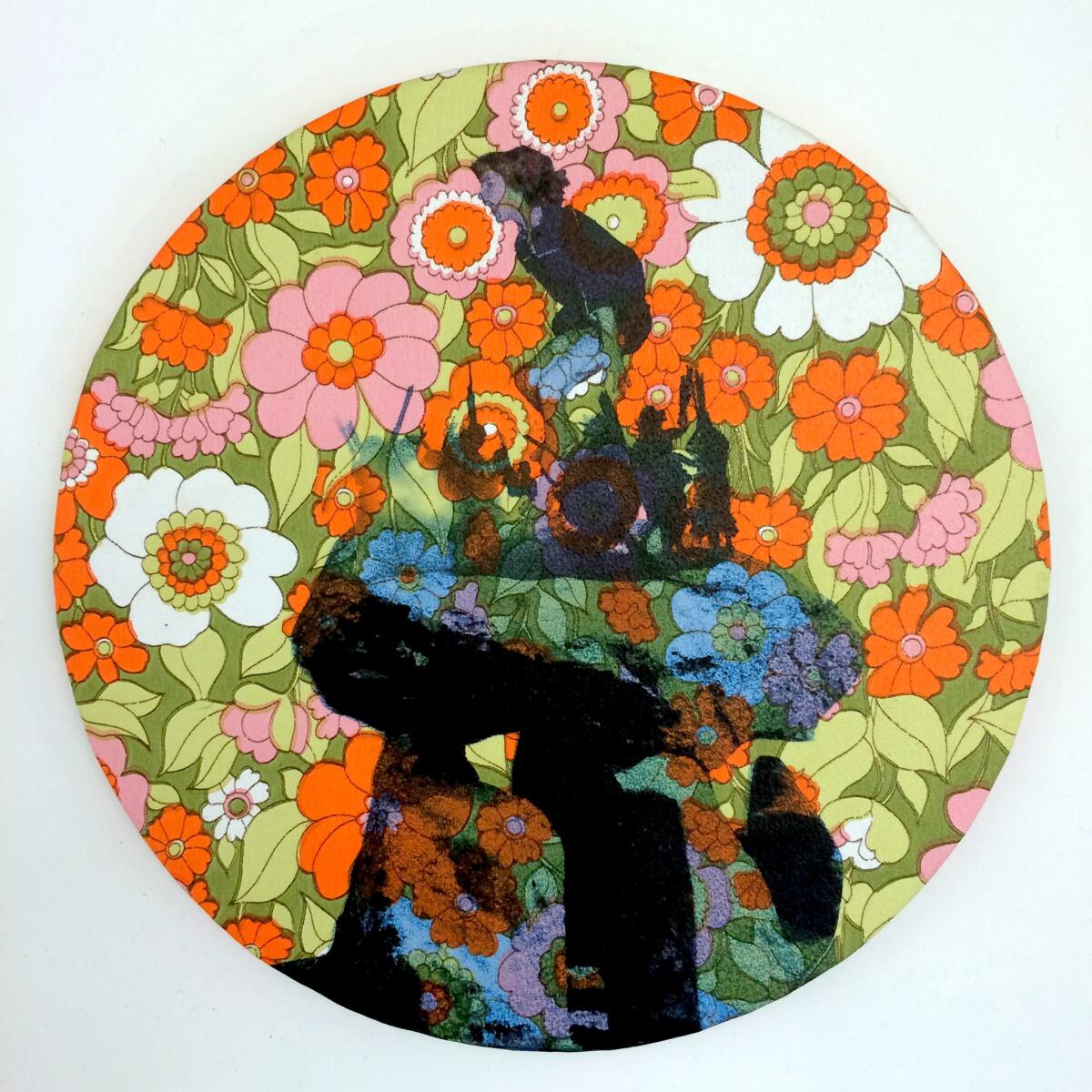
Elias Hansen, “Not Right Now,” at Team Gallery and Anat Ebgi. This two-part show consists of a series of sculptures that channel a bit of a jerry-rigged mad scientist vibe, including a large chandelier that is crafted from miscellany such as beakers, bulbs and other objects. Opens Saturday and runs through Dec. 16. 2660 S. La Cienega Blvd., Culver City, Los Angeles, anatebgi.com. Opens Sunday at 4 p.m. at Team Gallery and runs through Dec. 17. 306 Windward Ave., Venice, teamgal.com.
Rebecca Chernow, “#superbloom,” at the Grand Central Art Center. Using items that are often disposed of around Santa Ana, the artist has created her own tribute — in waste — of the wild blooms that happened in California poppy fields last spring. The piece explores what was left off the Instagram displays of all those desert blooms — the traffic and trash that accumulated as a result — while providing further opportunities for social media photography. Opens Saturday at 7 p.m. and runs through Jan. 17. 125 N. Broadway, Santa Ana, grandcentralartcenter.com.
Lynda Benglis, at Blum & Poe. The artist’s first show in Los Angeles in half a dozen years brings together sculptural works, including glazed ceramics, biomorphic aluminum sculptures, recent wall works crafted from paper and chicken wire, and an 11-foot phosphorescent sculpture called “Hills and Clouds.” Don’t miss the glazed fountains in the garden. Through Dec. 16. 2727 S. La Cienega Blvd., Culver City, blumandpoe.com.
A screening of “Dolores,” with Dolores Huerta and Barbara Carrasco, at the Institute of Contemporary Art Los Angeles. A screening of film about the famed labor leader will be followed by a chat between Huerta herself and Chicana painter Barbara Carrasco. Wednesday at 7 p.m. Admission is by donation. 1717 E. 7th St., downtown Los Angeles, theicala.org.
Last chance
“Chingaderas Sofisticadas,” at Kohn Gallery. The gallery has brought together nine artists from Guadalajara, a traditional craft center that is also a burgeoning hotbed of contemporary art. Showcasing works by artists such as Eduardo Sarabia, Cynthia Gutiérrez and Gonzalo Lebrija, among others, the show explores the lively intersection between materials and conceptualism — but also includes a stirring dash of politics. Through Saturday. 1227 N. Highland Ave., Hollywood, kohngallery.com.
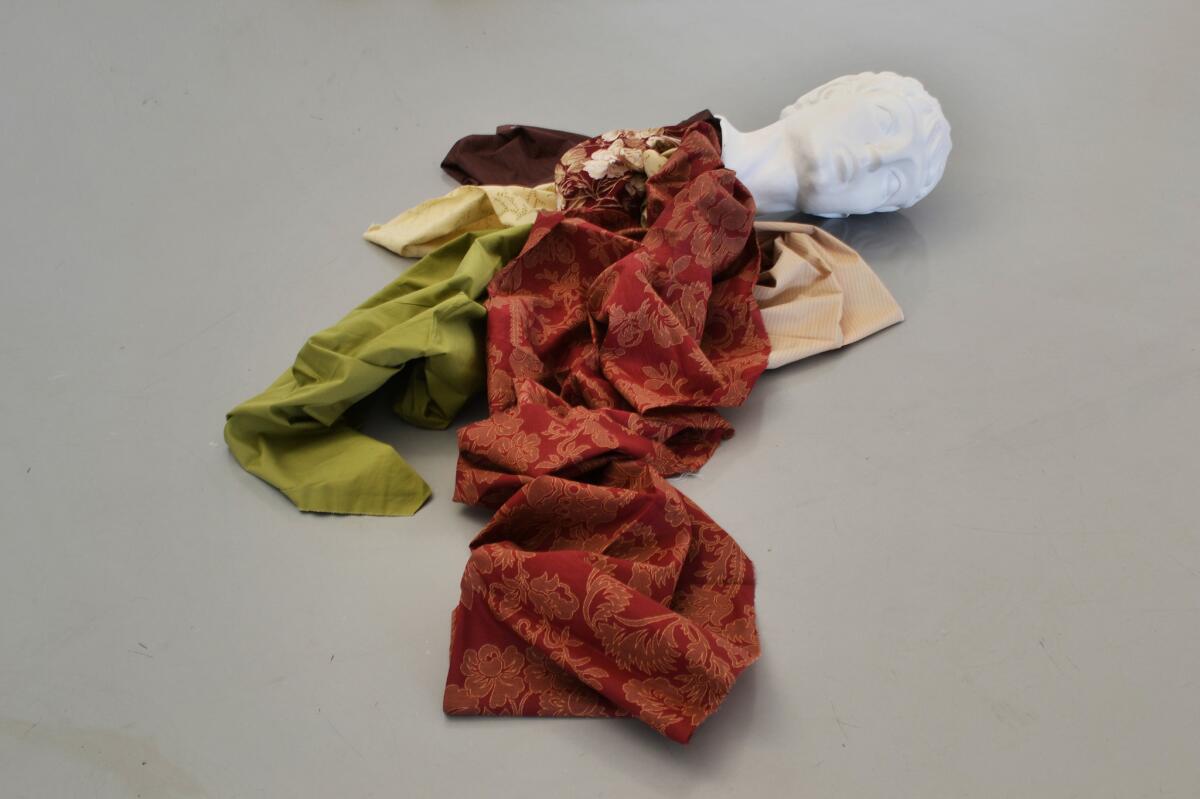
Jeremy Anderson, “Taking the World Apart is Easy, It is Getting it Back Together in an Acceptable Form that is Difficult,” at the Landing. A retrospective exhibition examines the work of a key Northern California sculptor, one known for abstracted works made from a wide range of materials, including wood and magnesite. These come together in alien-like biomorphic forms, totemic statues and abstracted landscapes. It’s the first large-scale survey of his work in more than 20 years and features sculptures and drawings made between 1950 and 1982. Through Saturday. 5118 W. Jefferson Blvd., West Adams, Los Angeles, thelandinggallery.com.
Amir H. Fallah, “A Stranger in Your Home,” at Shulamit Nazarian. In canvases that capture arrangements of figures, landscapes and objects, the Los Angeles painter channels aspects of the immigrant experience in the United States. Expect lush botanical scenes, layered textiles and figures that often remain an ambiguous part of their setting. Through Saturday. 616 N. La Brea Ave., Hollywood, shulamitnazarian.com.
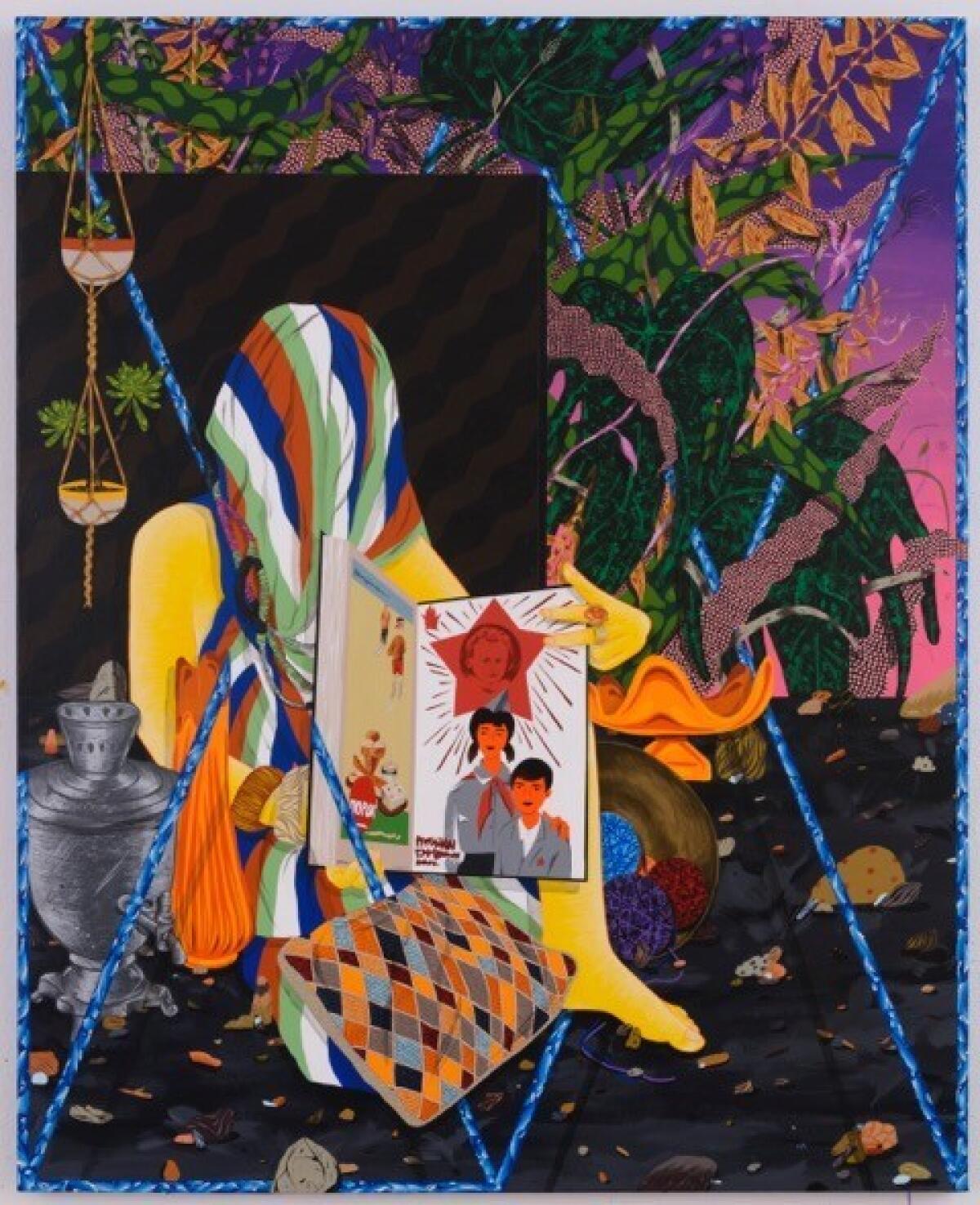
Ongoing exhibitions
Mary Corse, “Then and Now,” at Kayne Griffin Corcoran. One of the masters of the effects of light and space is back with a solo exhibition of works old and new that riff on the elusive nature of light and reflection, as well as shape and form. The show also features a piece she first conceived in the ’60s: a freestanding cube, chilled to near freezing, and outfitted inside with a floating square of light. Through Nov. 11. 1201 S. La Brea Ave., Mid-Wilshire, kaynegriffincorcoran.com.
Kim Dingle, “Yipes,” at Susanne Vielmetter Los Angeles Projects. The Los Angeles artist is presenting three new series of work in her first exhibition at Vielmetter. Dingle has frequently portrayed little girls in feral acts of distraction both in painting and installation — and she continues the theme in a pair of new series that touch on the theme, albeit in more abstracted ways. Also on view are a series of “nature” paintings that employ panels of flakeboard as the base for abstractions that riff on color and form. Through Nov. 11. 6006 Washington Blvd., Culver City, vielmetter.com.
“Nemesio Antúnez: Chilean Master,” at Couturier Gallery. When it comes to surrealism in Latin America, it is Chilean painter Roberto Matta who frequently gets all the props. But his countryman Nemesio Antúnez was a key part of the movement. This exhibition brings together 26 paintings and prints from the 1940s to the ’80s, covering the long arc of a productive career. Through Nov. 11. 166 N. La Brea Ave., Hancock Park, Los Angeles, couturiergallery.com.
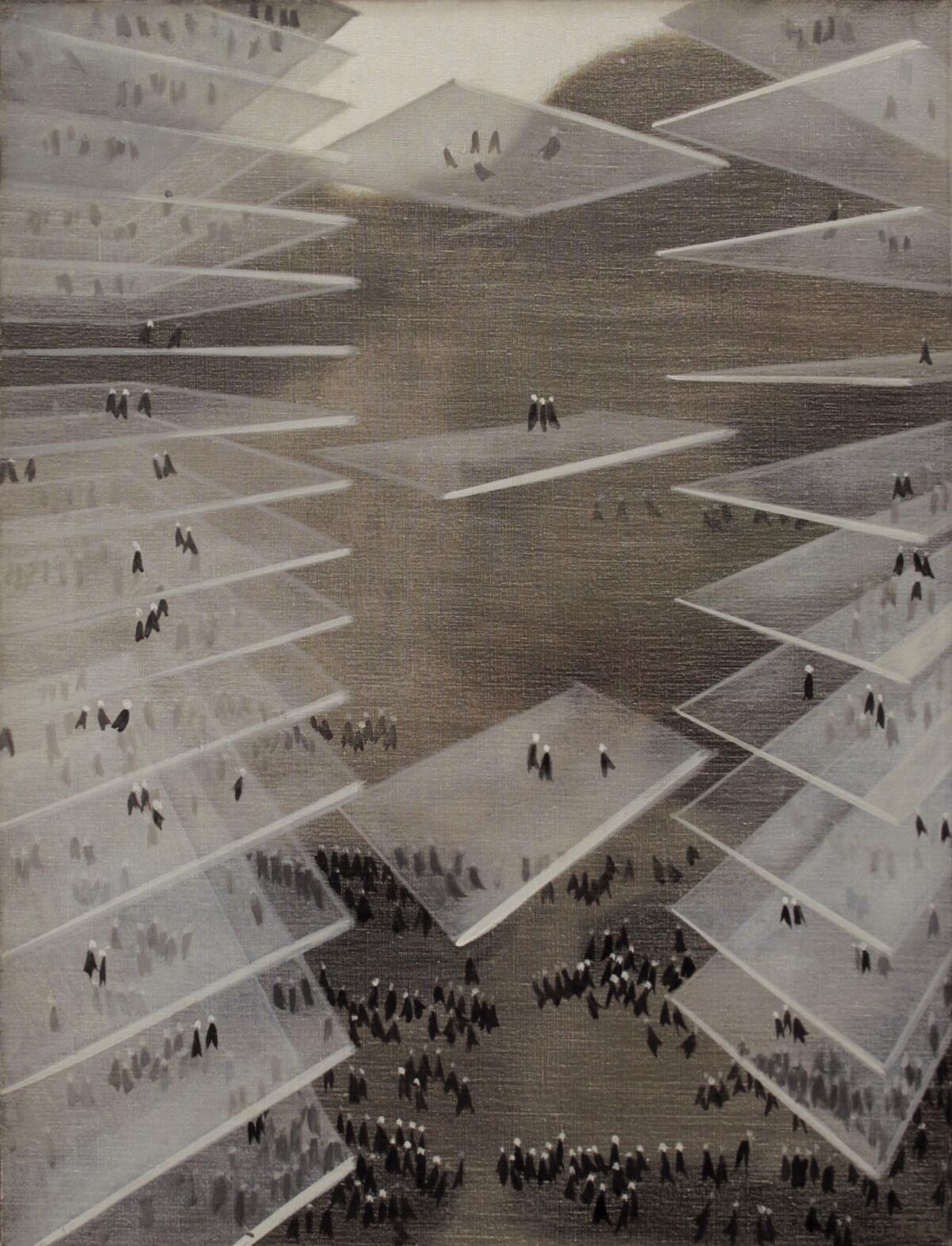
“The Mortal Machine: Art of Maxine Kim Stussy & Jan Stussy,” at Woodbury University. This is a follow-up to an earlier show by the L.A. art couple (that was held at Woodbury University’s gallery space on Hollywood Boulevard), and it focuses on the nature of the human body — including doll-like figurines that toy with aspects of anatomy. Organized by independent curator Michael Duncan, the show is a continuing investigation into the work of the Southern California pair. Through Nov. 12. 7500 Glenoaks Blvd., Burbank, facebook.com/nanraegallery.
“A Narrow Passage” at Noysky Projects. A group show at the Hollywood space has put together a range of works that deal with themes of “constriction, compression and concealment.” Expect works that are bound, wrapped and contain hidden layers. Artists featured include Katya Usvitsky, James Gilbert and Jenny Rask. Through Nov. 12. 6727 Hollywood Blvd., Hollywood, noyskyprojects.com.
[Eff] the Patriarchy, at Gas. This gallery operates out of a truck that parks around Los Angeles. For this politically minded show (note: it contains salty art language) figures such as Jibz Cameron, Roy Martinez, Ana Roldán, Gallery Y2K and Paul Chan and Badlands Unlimited take on the topic of refusal. As the press release notes, “especially relevant under
“DTLA: Works for Latin America,” by Track 16. Once located at Bergamot Station in Santa Monica, Track 16 is celebrating a new location in downtown Los Angeles, in the Bendix Building (near Santee Alley). The focus of the show, in keeping with the Latin America theme that is currently occupying the Los Angeles art world, is on contemporary works from the region, including painted illustrations by Peruvian conceptual artist Fernando Bryce, assemblage by the Argentinean collective Mondongo and ceramics by Mexican artist Luis Miguel Suro. Through Nov. 18. Bendix Building, 1206 Maple Ave., #1005, downtown Los Angeles, track16.com.
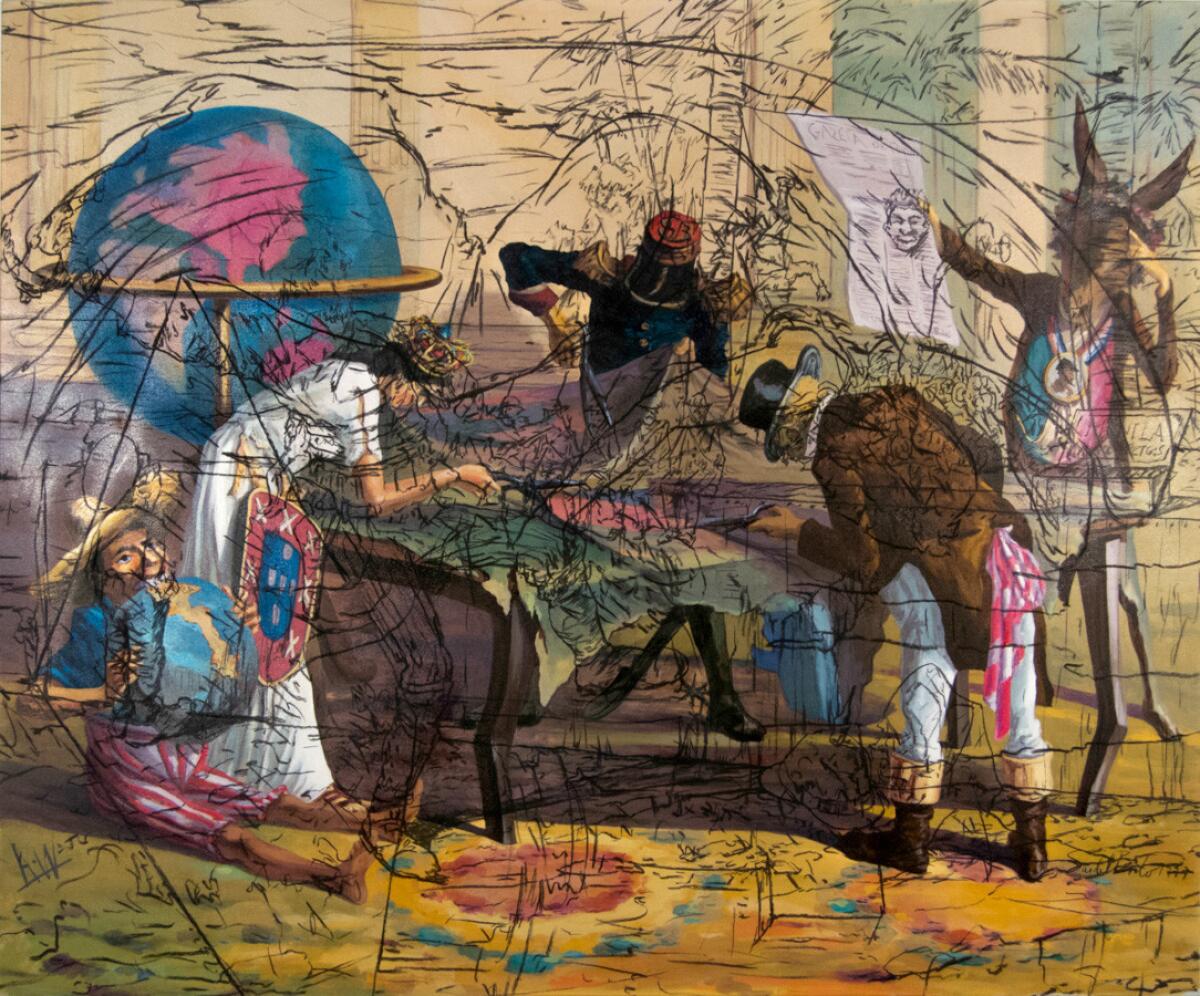
“A Woman’s Place…” at the William Grant Still Arts Center. This exhibition is inspired by the lives and work of five activist women of color: civil rights activists Angela Davis and Ericka Huggins, antiwar activist Yuri Kochiyama, community organizer Elizabeth “Betita” Martinez and health advocate Jewel Thais-Williams (who also happened to be the founder of one of L.A.’s pioneering gay nightclubs). The show will feature ephemera related to these women’s lives — as well as artwork inspired by their journeys. Through Nov. 18. 2520 South West View St., West Adams, Los Angeles, wgsac.wordpress.com.
Christina Fernandez, “Prospect,” at Gallery Luisotti. A series of photographs taken through windows capture blurred vistas at historic sites such as the Manzanar internment camp and the Point Fermin Lighthouse in San Pedro. Also included is the series “reflect/project(ion),” collaborative images in which Fernandez projects images onto individuals as she photographs them. Through Nov. 22. 2525 Michigan Ave., A2, Santa Monica, galleryluisotti.com.
Kelly McLane, “Peckerwoods,” at Denk. In her first solo show at the gallery, McLane is presenting a new series of deeply layered paintings — whose images often dwell on the grotesque, and whose surface often feature the violent evidence of gouging and burning. Through Nov. 22. 749 E. Temple St., downtown Los Angeles, denkgallery.com.
“Homeward Bound,” at Nicodim. A group show explores the idea of home not as sanctuary, but at a place where difficult secrets are often harbored. To this end, the gallery’s interior is being transformed into a literal home — with living room, dining room, bedroom and bathroom — featuring funny/unsettling/sinister works by the likes of Lisa Anne Auerbach, Bjarne Melgaard, Ruben Verdu and many others. Through Nov. 22. 571 S. Anderson St., Suite 2, Boyle Heights, Los Angeles, nicodimgallery.com.
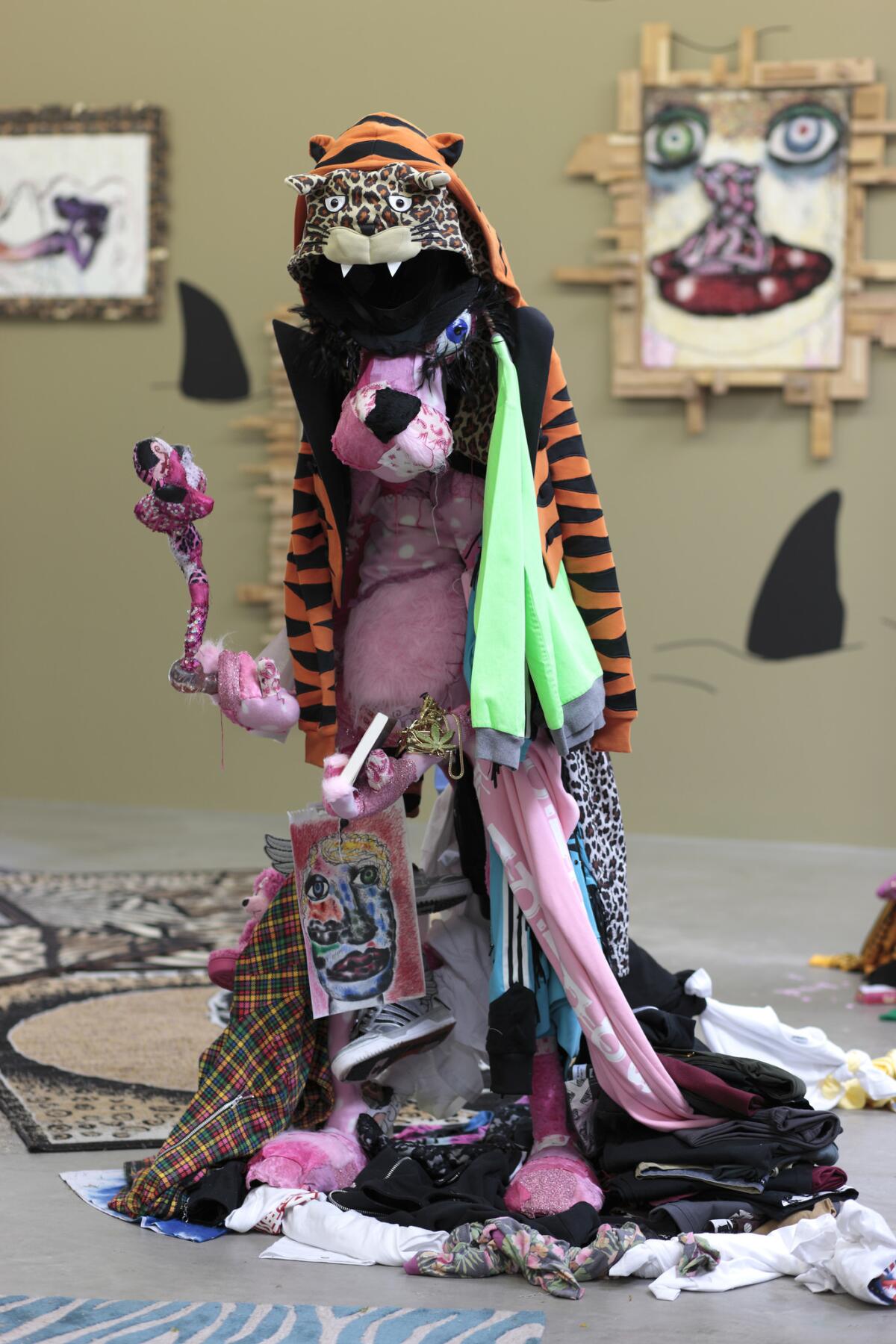
“James hd Brown: Life and Work in Mexico” at the Fisher Museum. Brown is the Glendale-born cofounder, with his wife Alexandra Maria Brown, of Carpe Diem Press, based in Oaxaca, an art book publishing house that has produced works by Graciela Iturbide, Joan Jonas, Dr. Lakra and Kiki Smith. This exhibition features elements from the book projects as well as Brown’s own artwork — with an eye toward how the cultural landscape in Mexico has helped shape his ideas. Through Dec. 2. 823 W. Exposition Blvd., Exposition Park, Los Angeles, fisher.usc.edu.
Juan Downey, “Radiant Nature,” at Los Angeles Contemporary Exhibitions and Pitzer College Art Galleries. A two-part exhibition looks at the work of the experimental, Chilean-born artist who was known for his happenings and participatory work, as well as installation pieces that explored the connection between nature and technology. Through Dec. 3 at LACE, 6522 Hollywood Blvd., Hollywood, welcometolace.org. Through Dec. 8 at Pitzer, 1050 N. Mills Ave., Claremont, pitzer.edu/galleries.
“South of the Border,” at the Loft at Liz’s. Artists with roots in 10 countries — including Lili Bernard, Joel García and Sandy Rodriguez — explore what it means to be an immigrant in the United States at this moment in time. Some of the work also focuses on the experience of the recipients of Deferred Action for Childhood arrivals program (known as
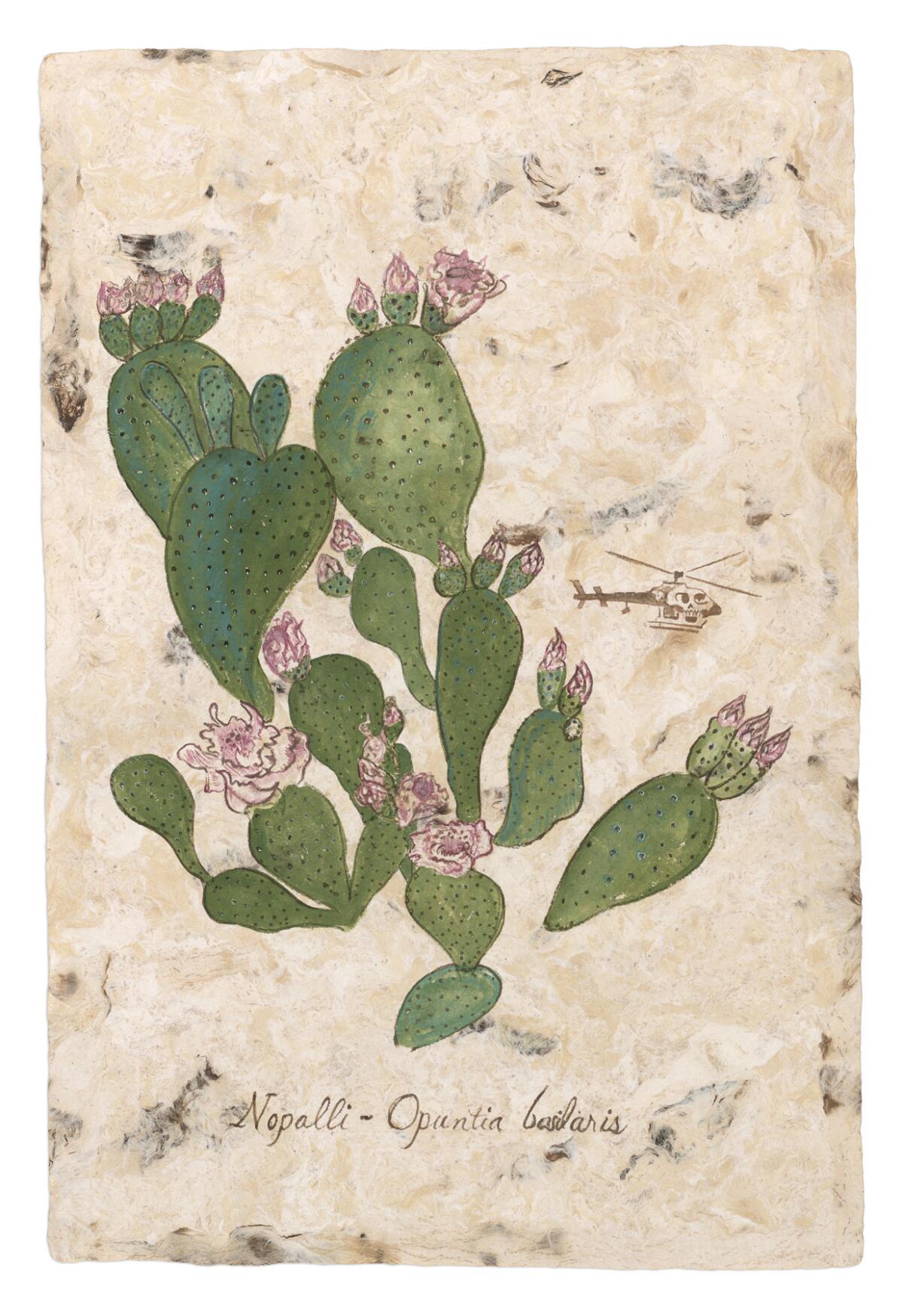
“Sacred Art in the Age of Contact: Chumash and Latin American Traditions in Santa Barbara,” at the Art, Design & Architecture Museum and the Santa Barbara Historical Museum. This is one of the key PST: LA/LA exhibits focusing on historical California — specifically, the early Mission period, when Spanish and indigenous communities first came into contact. The show is focused on religious objects made by individuals of both cultures, including sculpture and painting. At the Santa Barbara Historical Museum through Jan. 14. 136 East de la Guerra, Santa Barbara, sbhistorical.org. At the Art, Design & Architecture Museum through Dec. 8.
Pablo Helguera and Suzanne Lacy, “The Schoolhouse and the Bus,” at the Art, Design & Architecture Museum. This PST: LA/LA show in Santa Barbara pairs work by two artists well known in the field of social practice, both of whom have had mobile projects in the past. Lacy will be showing elements from “Skin of Memory,” a project that gathered personal objects from a Medellín neighborhood that was ground zero in the ’80s Colombian drug war — and that she showcased in a mobile museum that toured the neighborhood. Helguera, in the meantime, will display elements and documentation from his “School of Panamerican Unrest,” a portable schoolhouse structure that he took all over the Americas and used as a staging ground for discussions about Panamerican ideals and other topics. Through Dec. 8. UC Santa Barbara, 552 University Rd., Santa Barbara, museum.ucsb.edu.
“Playing With Fire: Paintings by Carlos Almaraz,” at the Los Angeles County Museum of Art. He was an activist and artist, a founder of the groundbreaking collective Los Four, but also a singular painter whose deeply saturated visions of Southern California — its car crashes and its landscapes — bordered on the hallucinatory. This exhibition represents the first major survey devoted to the Los Angeles artist, who died at the age of 48 from AIDS-related complications. The show features 65 works and will be accompanied by the publication of the first full-length monograph devoted to Almaraz’s life and work. Through Dec. 3. 5905 Wilshire Blvd., Mid-Wilshire, Los Angeles, lacma.org.
“¡Mírame! Expressions of Queer Latinx Art,” at La Plaza de Cultura y Artes. A group show brings together artists from various Latino backgrounds who explore issues of sexuality and identity in their art, including Xandra Ibarra, Alma Lopez, Julio Salgado and noted photographer Laura Aguilar, known for the striking portraits she creates of herself and others. Through Dec. 9. 501 N. Main St., downtown Los Angeles, lapca.org.
John Baldessari, at Sprüth Magers. For his latest exploration of vernacular culture — and the often disjointed relationship between text and image — the famed California conceptualist has turned to the emoji palette. A new series of inkjet paintings depict various glyphs paired with bits of theatrical text. Think of it as old world (painting) meeting new (the internet). Through Dec. 9. 5900 Wilshire Blvd., Mid-Wilshire, Los Angeles, spruethmagers.com.
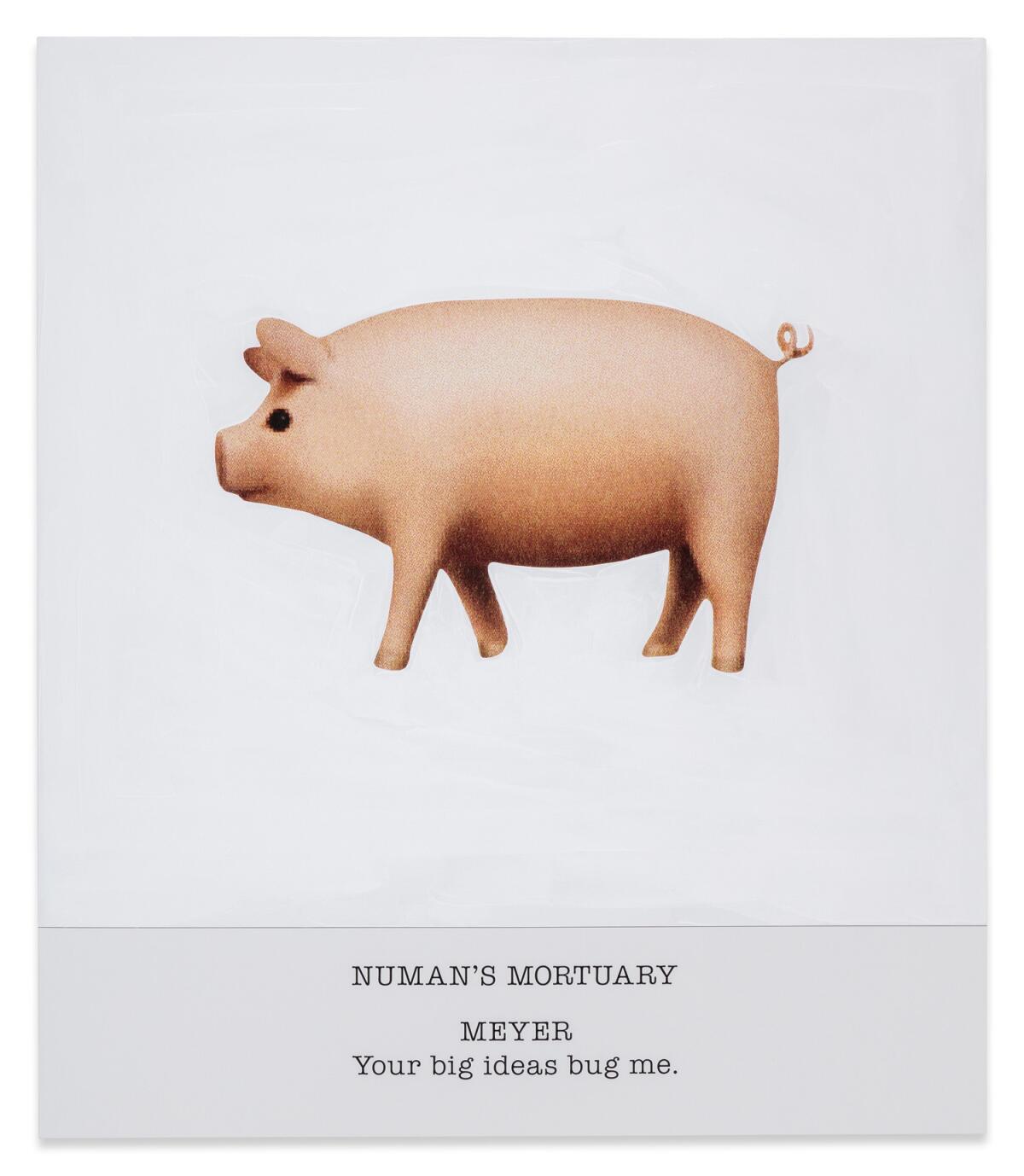
Fran Siegel, “Lineage Through Landscape: Tracing Egun in Brazil,” at the Fowler Museum. A large-scale drawing project by the Long Beach-based artist was inspired by a recent residency in Brazil, where she conducted research in, among other places, the Island of Itaparica, an important center of Afro-Brazilian religious practice. Her 40-foot-long piece consists of a weaving that brings together strips of fabric and drawings of sacred plants on translucent film — a record of the landscapes she inhabited, and the troubled histories some of those represent. Through Dec. 10. UCLA, 308 Charles E. Young Drive North, Westwood, Los Angeles, fowler.ucla.edu.
“David Lamelas: A Life of Their Own,” at the University Art Museum. This is the first monographic exhibition devoted to the pioneering conceptual artist, who first gained international attention in 1968 for his work “Office of Information about the Vietnam War at Three Levels,” staged at the Venice Biennale. The piece consisted of an office-style setting in which an attendant would intermittently deliver headlines about the war in three languages. This exhibition gathers many of Lamelas’ key works — including video installations, performance documentation and his post-minimalist sculptures. Through Dec. 10.
Carolyn Castaño, “A Female Topography,” at Laband Gallery. This is the first career survey of the Los Angeles painter known for brilliant canvases that explore issues of gender identity (particularly in Latin America), the cultural effects of the drug trade, and the social and environmental conditions faced by women in Colombia, the country her family hails from. Her work riffs ebulliently on tropical color palettes and pattern. This is one not to miss. Through Dec. 10. Loyola Marymount University, 1 LMU Drive, Westchester, Los Angeles, cfa.lmu.edu/labandgallery.
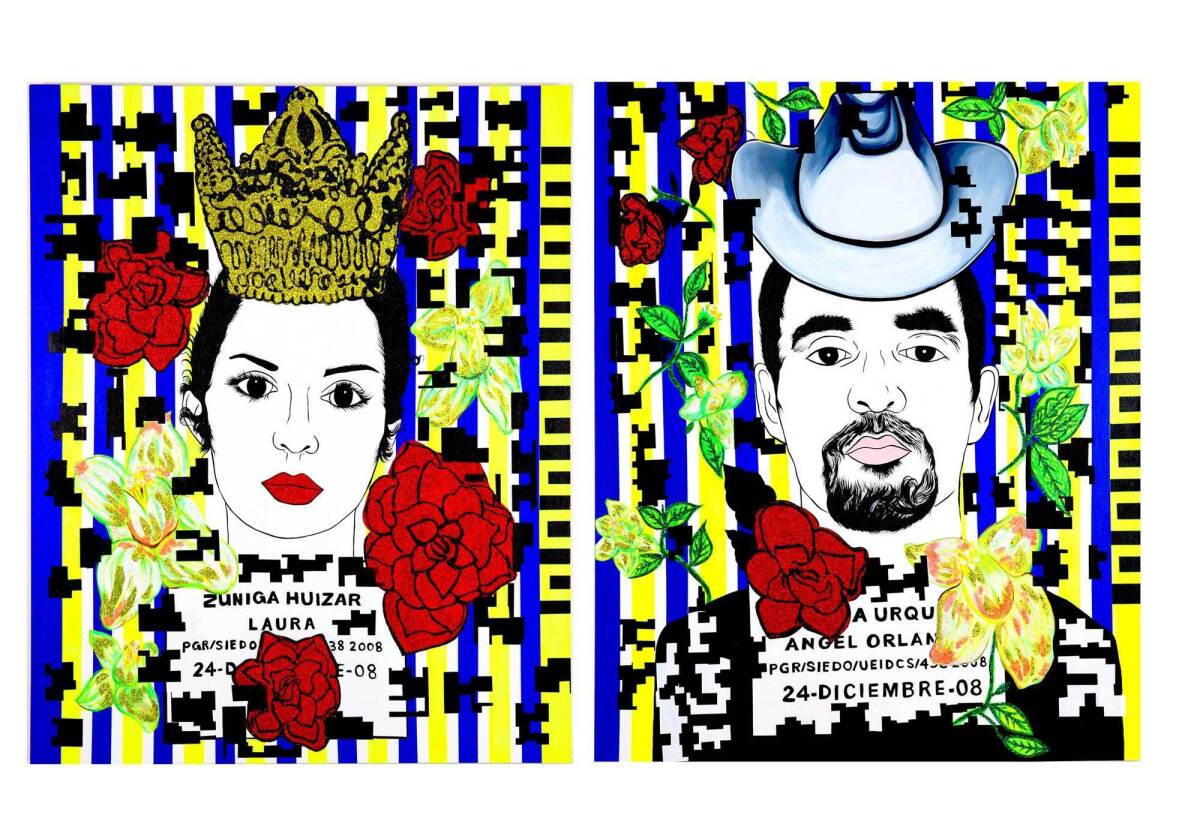
“A Universal History of Infamy: Virtues of Disparity,” at the 18th Street Arts Center. This represents Part 2 of the exhibition of the same name that recently opened at the Los Angeles County Museum of Art. The show includes 16 U.S. Latino and Latin American artists whose work often employs elements of research and anthropology and explores a range of global concerns. This will include small-scale pieces as well as three new projects produced for the site. Through Dec. 15. 1639 18th St., Santa Monica, 18thstreet.org.
“The Great Wall of Los Angeles: Judith F. Baca’s Experimentations in Collaboration and Concrete” at the University Art Galleries. This show surveys the nearly 50-year career of the Los Angeles muralist, known for the collaborative 2,754-long mural “The Great Wall,” painted in the Tujunga Flood Control Channel in the 1970s and now part of the National Register of Historic Places. Part of PST: LA/LA, the exhibition brings together photography, drawings and other ephemera related to Baca’s life and work. Through Dec. 16. Cal State University Northridge, 18111 Nordhoff St., Northridge, csun.edu.
Daniel Joseph Martinez, “I Am Ulrike Meinhof…” at Roberts & Tilton. This exhibition by the prominent Los Angeles artist examines the legacies of two important elements of German culture: the Berlin Wall and the life and ideas of German left-wing militant Ulrike Marie Meinhof. Inspired by Martinez’s time at the American Academy in Berlin, the installation is the artist’s own photographic map of the barriers that separated East from West in Cold-War-era Germany, punctuated by the presence of medieval-style standards outfitted with images of Meinhof, as well as the artist himself. Through Dec. 16. 5801 Washington Blvd., Culver City, robertsandtilton.com.
Eduardo Sarabia, “Drifting on a Dream,” at The Mistake Room. The L.A.-born, Guadalajara-based artist is known for a wide-ranging practice that includes fabricating tequila and creating traditional-looking ceramics that riff on popular culture, commerce and politics. The show, which functions as an immersive installation, includes a stage that will be employed for a range of events — including as a set for video that Sarabia is in the process of shooting. Through Dec. 16. 1811 20th St., downtown Los Angeles, tmr.la.
“Aztlán to Magulandia: The journey of Chicano artist Gilbert ‘Magu’ Luján,” at the University Art Galleries. This is the first museum survey of one of Chicano art’s most notable figures: Luján, a pioneering member of the 1970s collective Los Four, and a painter known for creating iconographic paintings and murals that featured anthropomorphic animal figures, pyramids that transform into dogs, highly stylized lowriders, and people and landscape. It was work that drew from pop as much as it did from indigenous themes. Through Dec. 16.
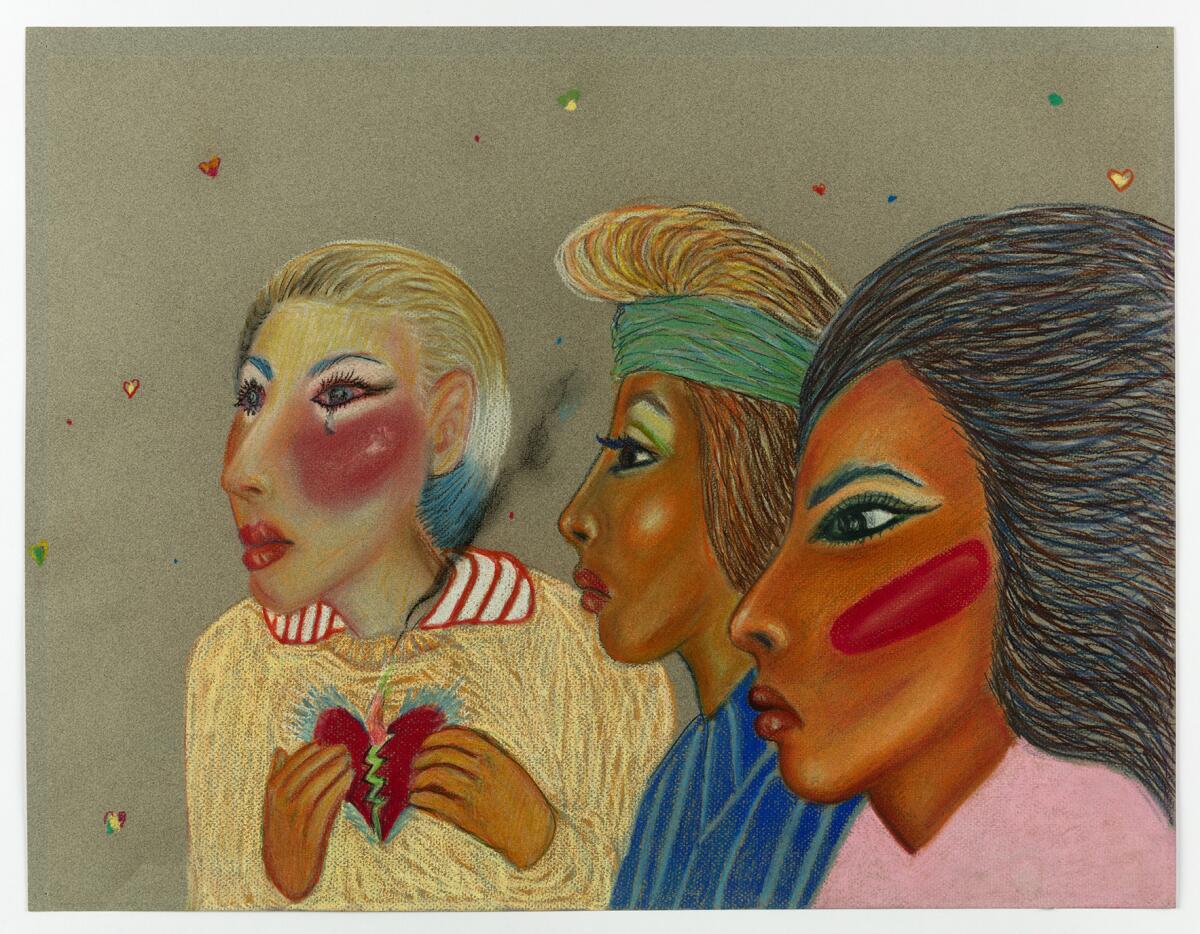
“Barrio Logos: Displacement and Iconography,” at Residency. A group exhibition organized by Oscar Magallanes looks at the most potent symbols of Chicano culture — from murals to fashion to car culture — that have been criminalized even as they have defined the Southern California aesthetic. The show includes work by Mile “El Mac” MacGregor, Patrick Martinez, Pablo Cristi, Vincent Valdez and others. Through Dec. 16. 310 E. Queen St., Inglewood, residencyart.com.
“Prometheus 2017: Four Artists from Mexico Revisit Orozco,” at the Pomona College Museum of Art. Pomona College is the site of an important mural by Mexican master José Clemente Orozco. For this PST: LA/LA exhibition, the curators have gathered the work of four female artists working in Mexico — Isa Carrillo, Adela Goldbard, Rita Ponce de León and Naomi Rincón-Gallardo — whose work resonates with Orozco on topics such as history, justice, power and storytelling. At 7 p.m. Nov. 18, Goldbard will perform a fireworks exhibit in conjunction with the show — so mark your calendars. Through Dec. 16. 330 N. College Ave., Claremont, pomona.edu/museum.
“Video Art in Latin America,” at LAXART. A comprehensive look at the history of video art in Latin America, this group exhibition brings together more than 60 works from all over the continent dating back to the 1960s. Organized by theme (instead of region or chronology), the works cover subjects such as political memory, the body and crisis. Through Dec. 16. 7000 Santa Monica Blvd., Hollywood, laxart.org.

“Coastal/Border,” at the Angels Gate Cultural Center. As part of PST: LA/LA, the San Pedro cultural center has put together an exhibition of performance and installation, organized by Raquel Gutiérrez and Martabel Wasserman, that has artists engaging with the coast and its various meanings. This includes a choir performance, a ritual happening and a screening of “Greeting Friends” by Paul Pescador, which reconsiders Walt Disney’s famous
“Alfredo Ramos Martínez and Latin American Modernism,” at Louis Stern Fine Arts. The art of the prominent Mexican Modernist painter (Ramos’ work is in the permanent collection of the L.A. County Museum of Art) is juxtaposed against the work of other important Latin American artists, including Claudio Bravo, Carlos Cruz-Diez, Manuel Ojeda and other key figures of the 20th century. Through Dec. 23. 9002 Melrose Ave., West Hollywood, louissternfinearts.com.
Dinh Q. Lê, “The Scrolls: Distortion,” at Shoshana Wayne Gallery. In his seventh solo show at the gallery, the Vietnam-based artist has created a series of scrolls that feature an image that has been relentlessly stretched but which still retains aspects of the recognizable. The work nods to traditional scroll painting (in which only a small piece of the scroll is unfurled at any one time) but also plays with the nature of photography. An adjacent gallery displays images woven into large textile-like objects that employ Vietnamese mat-weaving techniques. Through Dec. 23. Bergamot Station, 2525 Michigan Ave., B1, Santa Monica, shoshanawayne.com.
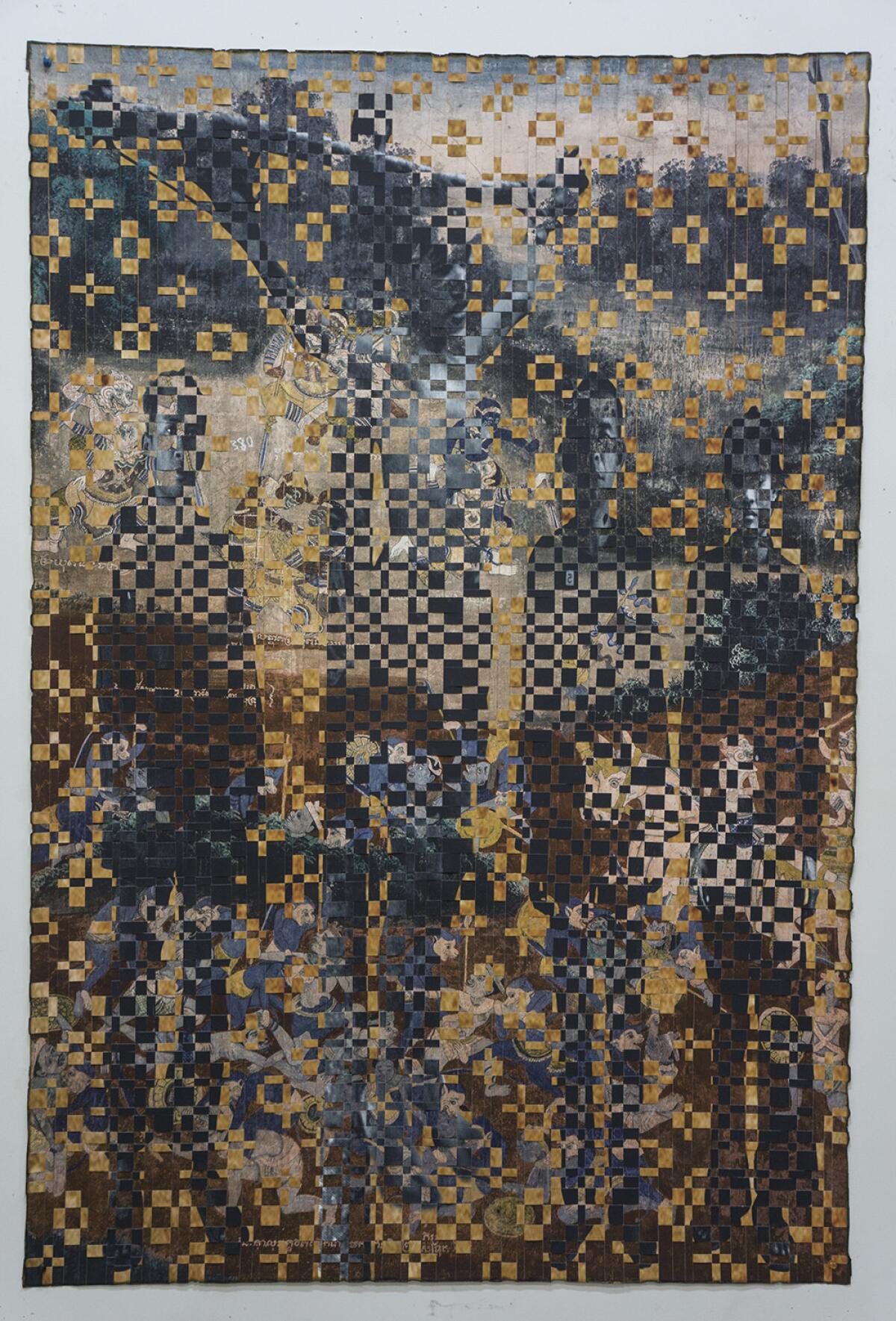
“We the People: Serving Notice,” at the American Museum of Ceramic Art. Directly engaging the complicated politics of our era, the museum has invited a range of ceramics artists to create works that “serve notice” on a range of contemporary issues, including immigration, human rights, freedom of speech and myriad other topics. This includes work by Jessica Putnam-Phillips, Peter Olson, Robert Lugo and many others. Through Dec. 30. 399 N. Garey Ave., Pomona, amoca.org.
“Radical Women: Latin American Art 1960-85,” at the Hammer Museum. Years in the making, this exhibition by independent curators Andrea Giunta and Cecilia Fajardo-Hill, is a survey of art by groundbreaking Latin American and U.S. Latina artists and the ways in which they used the body as canvas and subject. It will bring together artists from all over the continent, some laboring in oppressive social conditions; others, in outright dictatorships — and it will write into the history books work by women that is too often overlooked. Through Dec. 31. 10899 Wilshire Blvd., Westwood, Los Angeles, hammer.ucla.edu.
“Martín Ramírez: His Life in Pictures, Another Interpretation,” at ICA LA. The self-taught artist Martín Ramírez has drawn the attention of museums in the past for the bold, stylized drawings of horses, trains and caballeros he made over decades while institutionalized in a California psychiatric institution during the 20th century. The show represents the debut of the ICA LA in its new downtown space. It was formerly the Santa Monica Museum of Art. Through Dec. 31. 1717 E. 7th St., downtown Los Angeles, theicala.org.
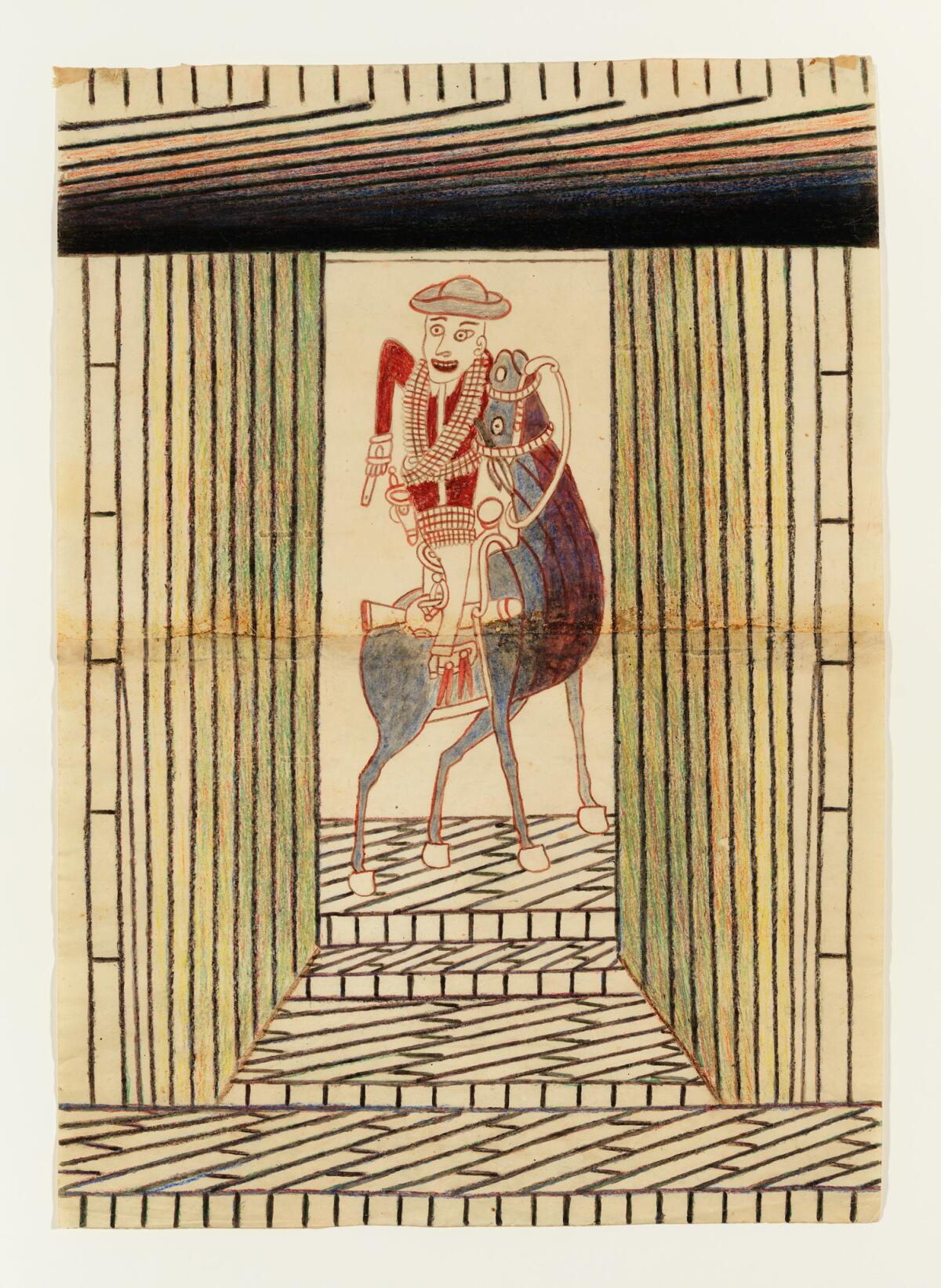
Anna Maria Maiolino, at the Museum of Contemporary Art. This is the first comprehensive U.S. museum survey of the work of the Italian-born Brazilian artist, who over the course of her restless, five-decade career has explored themes of repression, marginalization and womanhood. This includes photography, performance and three-dimensional assemblage. A large room contains one of her vast unfired-clay installations — bursting with small and large forms — a tribute to process and viscera. This too is part of the PST: LA/LA circuit. And it’s one not to miss. Through Dec. 31. 250 S. Grand Ave., downtown Los Angeles, moca.org.
“Nervously Engendered: The Art of Gerardo Velazquez,” at Coagula Curatorial. The pioneering East L.A. musician, founder of the band Nervous Gender, was as much about making experimental music as he was about creating a queer Chicano aesthetic. This show gathers his art work and ephemera from his music career. Through Dec. 31. 974 Chung King Road, Chinatown, Los Angeles, coagulacuratorial.com.
Axis Mundo: Queer Networks in Chicano L.A., at MOCA Pacific Design Center and ONE Gallery. This is another ground-breaking PST: LA/LA exhibition. On view in two locations in West Hollywood, it tracks the art, music and performance work of a network of queer avant-garde artists from Los Angeles contending with issues such as sexuality, feminism, identity, punk music and their racial and ethnic identities. Through Dec. 31. At MOCA PDC, 8687 Melrose Ave., West Hollywood, and ONE Gallery, West Hollywood, 9007 Melrose Ave., West Hollywood, one.usc.edu.
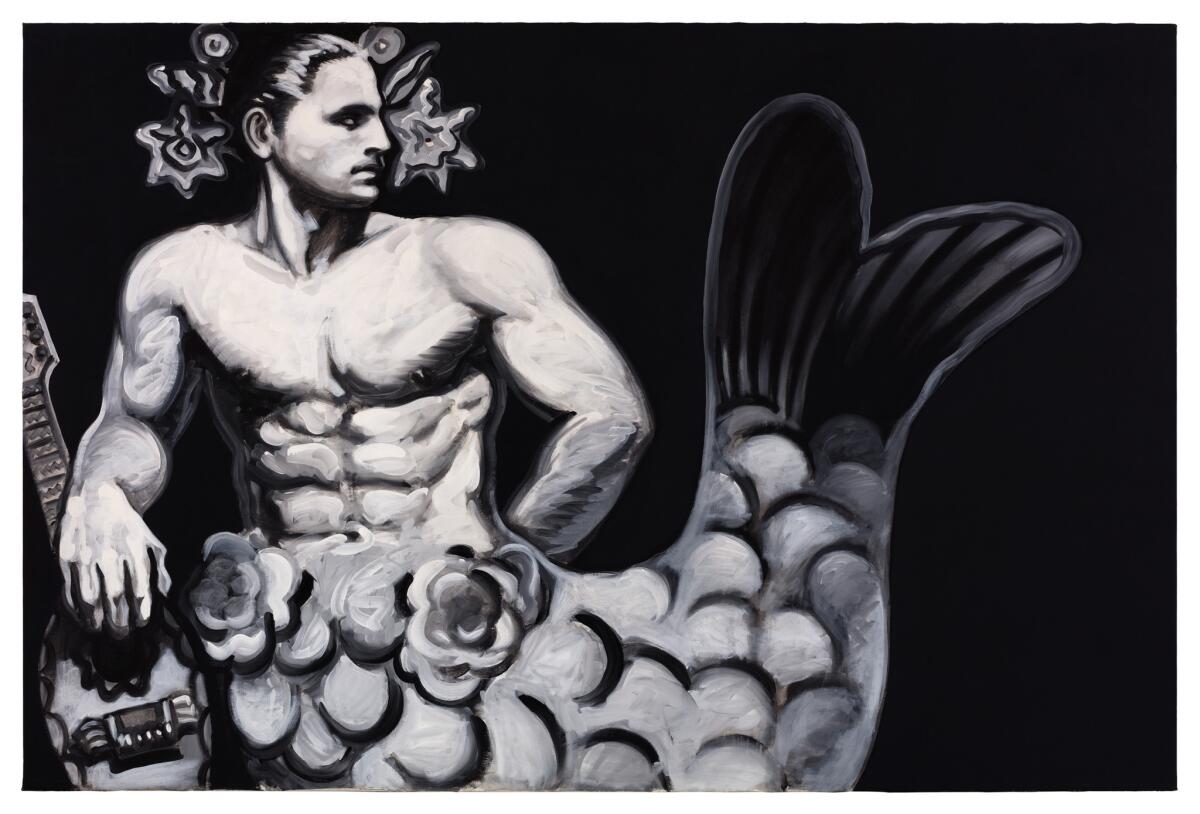
“Neo Native: Toward New Mythologies,” at the Maloof Foundation. This exhibition features more than 40 works by 11 contemporary U.S. artists with Native American roots — including painting, photography, ceramics and more. This includes works by painter Gerald Clarke Jr., ceramicist Diego Romero, conceptual artist Cannupa Hanska Luger and photographer Cara Romero. Opens Sunday and runs through Jan. 7. 5131 Carnelian St., Alta Loma, malooffoundation.org.
“Chagall: Fantasies for the Stage,” at the Los Angeles County Museum of Art. Marc Chagall frequently depicted musicians and dancers in his paintings. He also painted the sets and costumes in which they performed. This exhibition at LACMA, organized by the Montreal Museum of Fine Arts in Canada, gathers Chagall’s costumes, set designs and other ephemera from four productions: the ballet “Aleko,” Stravinsky’s “The Firebird,” Maurice Ravel’s “Daphnis and Chloé” and Mozart’s opera “The Magic Flute.” Expect pure, wondrous theater. Through Jan. 7. 5905 Wilshire Blvd., Mid-Wilshire, Los Angeles, lacma.org.
“The U.S.-Mexico Border: Place, Imagination and Possibility,” at the Craft & Folk Art Museum. Given the political climate, a show about the U.S.-Mexico border could not be more poignant. And this particular exhibition looks at how the world’s most heavily demarcated dividing line has inspired all manner of thinking about art, architecture, design, sculpture, photography and painting. If only our political leaders would go see it. Through Jan. 7. 5814 Wilshire Blvd., Mid-Wilshire, cafam.org.
“Hollywood in Havana: Five Decades of Cuban Posters Promoting U.S. Films,” at the Pasadena Museum of California Art. Part of the Pacific Standard Time: Los Angeles / Latin America series, this exhibition gathers five decades of Cuban posters promoting Hollywood films such as “Moby Dick” and Charlie Chaplin’s “The Kid” (a.k.a. “El Chicuelo”) — a whirlwind graphic tour of film history through a Caribbean lens. The museum also has an exhibition devoted to the work of California painter E. Charlton Fortune, a Californian known for creating impressionist and Modernist landscapes, as well as a range of ecclesiastical work. Through Jan. 7. 490 E. Union St., Pasadena, pmcaonline.org.
“Visual Voyages: Images of Latin American Nature from Columbus to Darwin,” at the Huntington Library. A sumptuous exhibition surveys art, science and environment in Latin America through the publications and drawings of the myriad scientists and explorers who have visited the continent. The show consists of approximately 100 objects drawn from the Huntington’s holdings and dozens of other collections, including illustrated manuscripts, rare books, drawings, and one singularly brilliant feathered cape. Through Jan. 8. 1151 Oxford Rd., San Marino, huntington.org.
“We Wanted a Revolution: Black Radical Women. 1965-85,” at the California African American Museum. A group show focuses on work by African American women artists and seeks to expand the conversation about social justice and feminism to include the many black artists who were also engaged in struggles for equality — both gender and racial. The exhibition includes work by key U.S. artists, including Betye Saar, Lorna Simpson, Maren Hassinger, Alison Saar and Lorraine O’Grady, among countless others. All I gotta say is: yes to this show! Through Jan. 14. 600 Exposition Drive, Exposition Park, Los Angeles, caamorg.
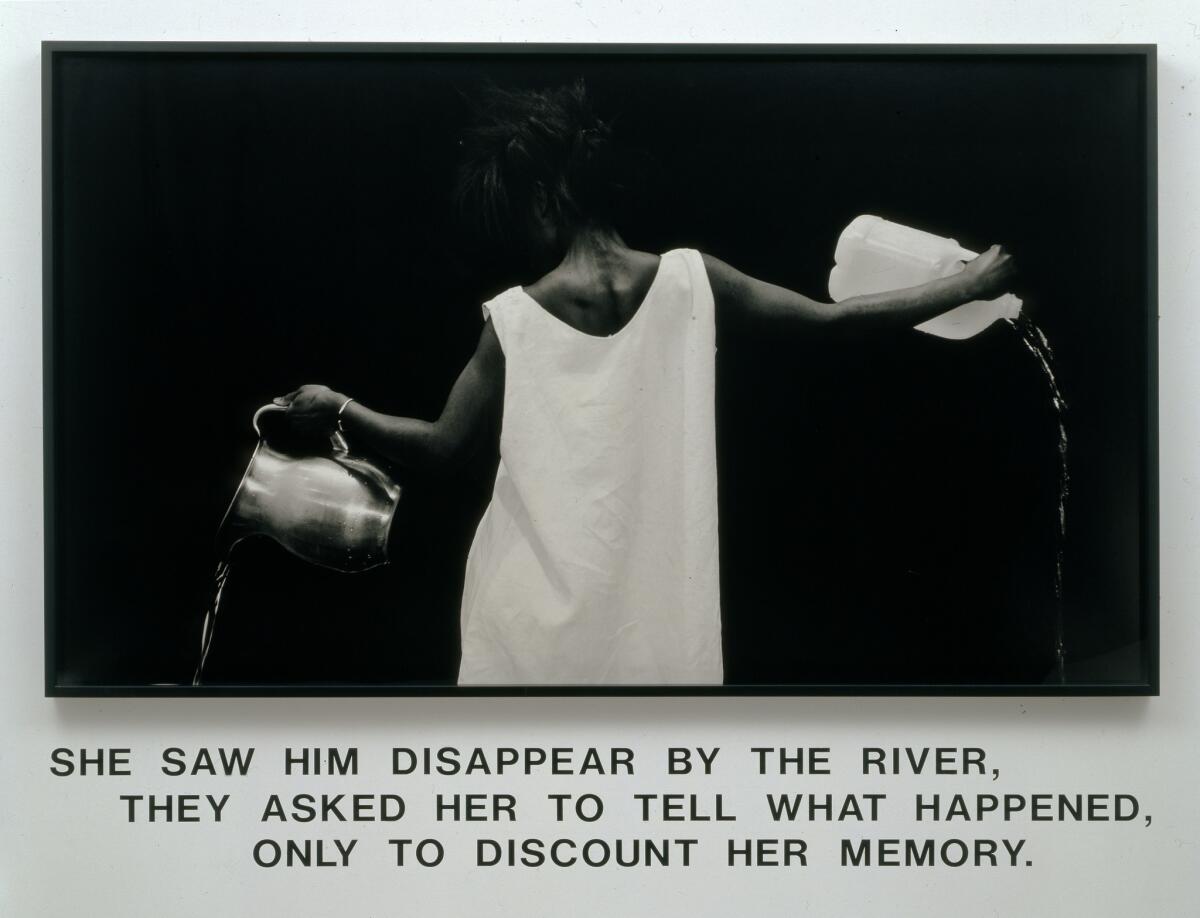
“How to Read El Pato Pascual: Disney’s Latin America and Latin America’s Disney,” at the MAK Center and the Luckman Fine Arts Center. Organized by curator Jesse Lerner and artist Ruben Ortiz-Torres, this intriguing exhibition looks at the ways in which Disney was influenced by Latin America and how Latin America has taken Disney cartoon characters and coopted them for its own purposes. It’s a comprehensive look at how culture is reflected back and forth between the U.S. and Latin America — one based on imagery crafted in Disney’s studio right in Los Angeles. For students of history, the related catalog is a must. Through Jan. 14. MAK Center, 835 N. Kings Road, West Hollywood, makcenter.org. Luckman Fine Arts Center, 5151 State University Drive, Los Angeles, luckmanarts.org.
Maya Gurantz, “Deipnophoroi,” at the Grand Central Art Center. This video installation is Inspired by an ancient Greek festival documented by the essayist Plutarch, in which a community would reenact a mythical ritual of sending young men to be fed as sacrifice to the Minotaur. As part of it, women were allowed to bring food to comfort their children as they faced terrible death. Gurantz has created a video diptych that reflects on the idea of a mother preparing her child for “the unutterable.” Through Jan. 14. 125 N. Broadway, Santa Ana, grandcentralartcenter.com.
“Giovanni Bellini: Landscapes of Faith in Renaissance Venice” at the Getty Museum. Bellini was one of the most influential painters to emerge out of the European Renaissance. This exhibition looks at the ways in which the painter employed landscapes in his religious paintings, producing naturalistic backdrops that added an unprecedented element of reality to the art of the era. Through Jan. 14. 1200 Getty Center Drive, Brentwood, Los Angeles, getty.edu.
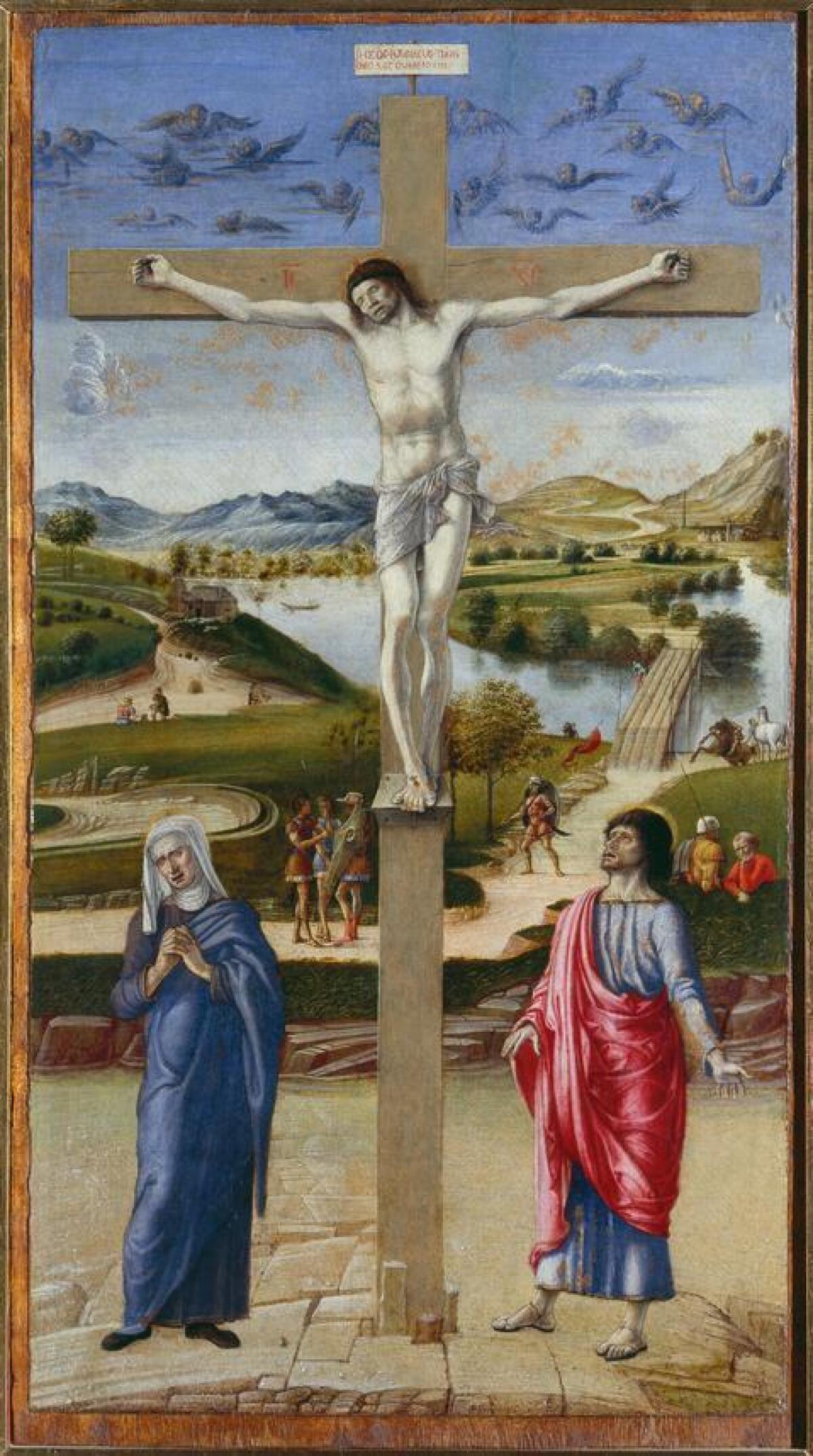
“Kinesthesia: Latin American Kinetic Art, 1954-1969,” by Palm Springs Art Museum. Paris has long been thought of as the heart of the kinetic art movement — art that plays with light, form and shape to create a sensory experience. But this exhibition, organized by guest curator Dan Cameron as part of the Pacific Standard Time: Los Angeles / Latin America series, looks at the contributions to the movement by important South American figures. This includes innovative work by key figures as Carlos Cruz-Diez, Julio Le Parc and Martha Boto. Definitely worth a weekend in the desert. Through Jan. 15. 101 N. Museum Dr., Palm Springs, psmuseum.org.
“Memories of Underdevelopment: Art and the Decolonial Turn in Latin America, 1960-85,” at the Museum of Contemporary Art San Diego. A group exhibition organized in collaboration with the Museo Jumex in Mexico City and the Museo de Arte de Lima in Peru focuses on the ways in which Latin American artists have contended with the evaporating promise of Modernism in the 1960s through the 1980s — a period racked by instability and brutal dictatorships — with wildly experimental and politically charged works. The show includes pieces by figures such as Hélio Oticica, Lygia Pape, Eugenio Espinoza and others. This is a PST: LA/LA must-see. Through Jan. 21. 1100 Kettner Blvd., San Diego, mcasd.org.
“Mike Kelley: Kandors 1999-2011,” at Hauser & Wirth. This will be the first comprehensive survey of Kelley’s “Kandors” series, which reimagines the fictional city from the Superman comics — the capital of Krypton, which was shrunk and kept in a jar by a supervillain. The show includes the artist’s oversized sculptures that depicted the imagined city, as well as drawings and Lenticular pieces. Through Jan. 21. 901 E. 3rd St., downtown Los Angeles, hauserwirthlosangeles.com.
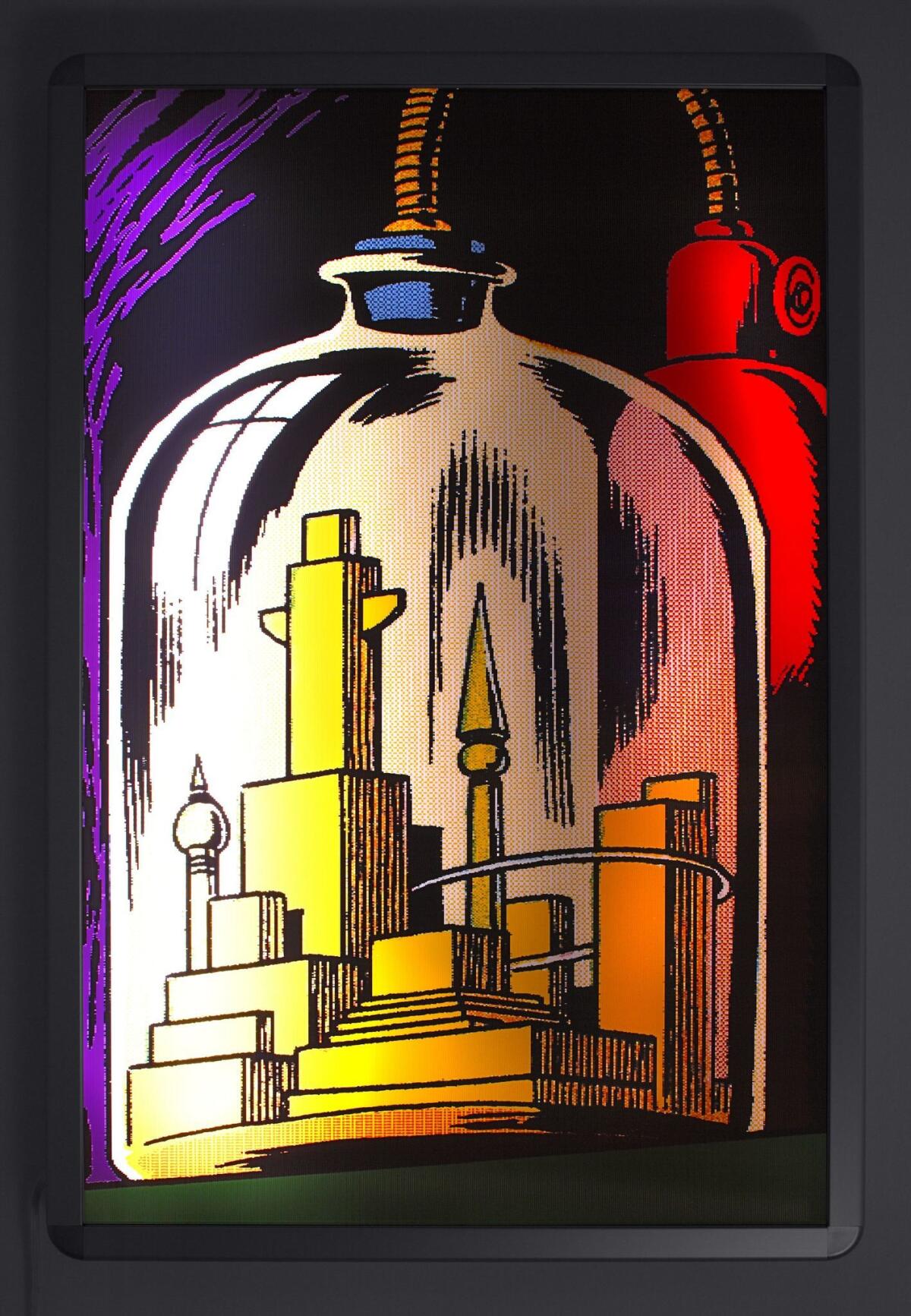
“Below the Underground: Renegade Art and Action in 1990s Mexico” at the Armory Center for the Arts. With Mexico City in the process of recovering from a 7.1 earthquake, it could not be a more timely moment for this exhibition, which looks at the underground movements and artists who helped shape the scene of the ’90s. (A scene, formed in part, by the DIY spirit that arose in response to Mexico City’s devastating 1985 quake.) The show, part of the PST: LA/LA series of exhibitions, includes work by figures such as Eduardo Abaroa, Teresa Margolles and the collective Pinto Mi Raya. Through Jan. 22. 145 N. Raymond Ave., Pasadena, armoryarts.org.
Ruben Ochoa, “Sampled y Surveyed,” at Art + Practice. Over the course of his career, the Oceanside-born artist has long used elements of the urban landscape as his primary material: chain link, concrete, steel and bits of earth. In fact, Ochoa once quite famously jammed a slab of wall and a mound of earth into a room for an installation that looked as if a destabilized portion of freeway had crashed into a white cube. This exhibition at Art + Practice considers Ochoa’s large-scale pieces and the ways in which they employ, manipulate and transform space. Through Jan. 27. 3401 W. 43rd St., Leimert Park, Los Angeles, artandpractice.org.
“Judithe Hernández and Patssi Valdez: One Path Two Journeys,” at the Millard Sheets Art Center. Two of Los Angeles’ most iconic Chicana artists come together for this two-woman show, which features a broad selection of current works as well as a new collaborative installation. The Millard Sheets Art Center is at the L.A. County Fairgrounds, which means that after you check out the show, you can always pop into the fair for some funnel cake. Through Jan. 28. 1101 W. McKinley Ave., Pomona, pacificstandardtime.org.
“Golden Kingdoms: Luxury and Legacy in the Ancient Americas,” at the Getty Museum. An international exhibition featuring more than 300 masterpieces from throughout Latin America chronicles the most refined examples of craft and artisanry from about 1000 BC to the arrival of the Europeans. This includes sumptuous works of gold, ceramic, painting and textile from the ancient kingdoms of Peru, Mexico, Guatemala and Colombia. Through Jan. 28. 1200 Getty Center Dr., Brentwood, Los Angeles, getty.edu.
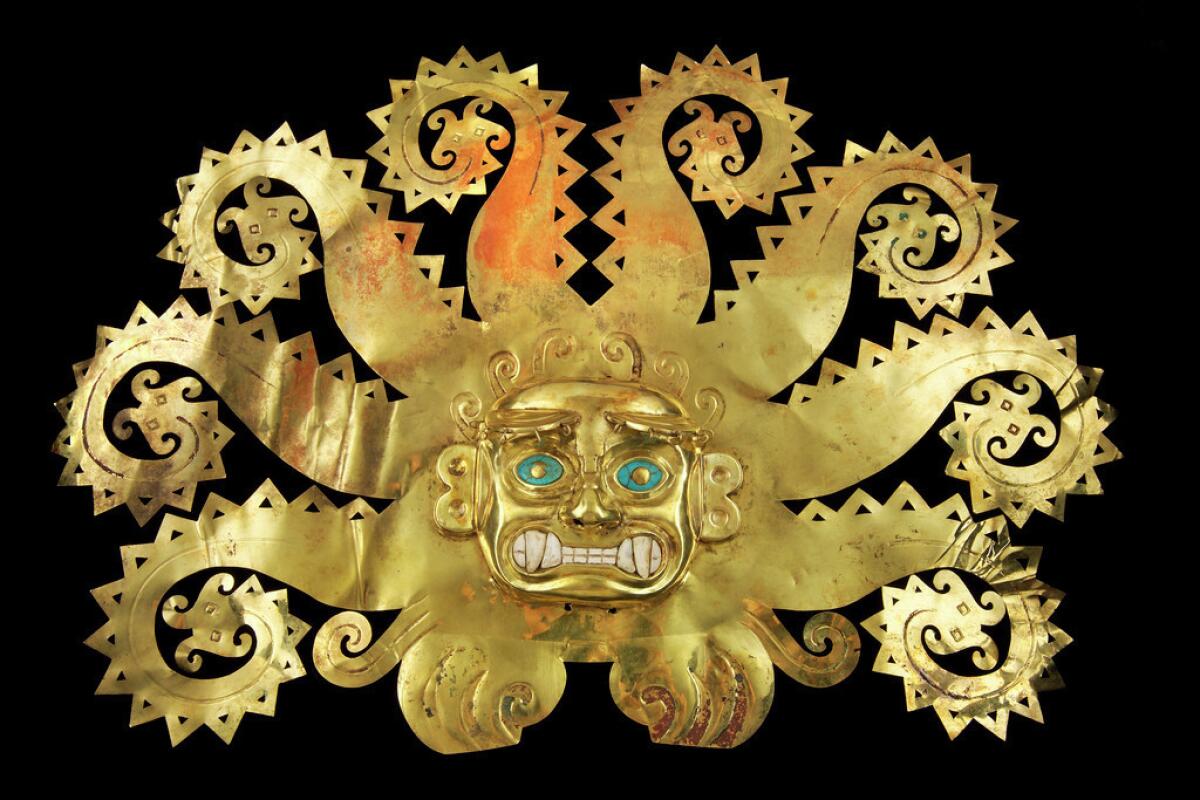
“Condemned to be Modern,” at the Los Angeles Municipal Art Gallery. This exhibition looks at the ways in which Latin American artists have contended with the legacy of Modernist architecture throughout the continent, looking at its innovations, and the ways it has and hasn’t fulfilled its utopic ideals in countries such as Mexico, Cuba and Brazil. Through Jan. 28. 4800 Hollywood Blvd., Hollywood, lamag.org.
Laura Aguilar, “Show and Tell,” at the Vincent Price Art Museum. This is the first comprehensive retrospective devoted to the Southern California photographer, who chronicled queer life in Los Angeles, and also devoted a good portion of her photographic practice to visceral self-portraits she staged in the wilderness. These play with texture, form, body image and what it means to be a woman. It’s a long overdue look at a singular L.A. photographer. Through Feb. 10. 1301 Cesar Chavez Ave., Monterey Park, vincentpriceartmuseum.org.
“Kukuli Velarde: Plunder Me Baby,” at the American Museum of Ceramic Art. The U.S.-based Peruvian artist is known for producing sculpture, inspired by indigenous ceramics, that use ancient symbols to tweak contemporary culture and its prejudices. Through Feb. 11. 399 N. Garey Ave., Pomona, amoca.org.
“La Raza,” at the Autry Museum of the American West. In its day, the civil rights publication “La Raza,” which was based in Lincoln Heights, served as a bible for the Chicano movement, covering protest, policy and everyday life for the Mexican American communities of Los Angeles. Over the years, the paper amassed an archive of 25,000 images, recently digitized by the Chicano Studies Research Center. Many are now on view as part of this PST: LA/LA show at the Autry — and in a time of political strife surrounding the issues of civil rights, this exhibition couldn’t be more timely. Also on view is Harry Gamboa Jr.’s photographic series “Chicano Male Unbonded.” Through Feb 10. 4700 Western Heritage Way, Griffith Park, Los Angeles, theautry.org.
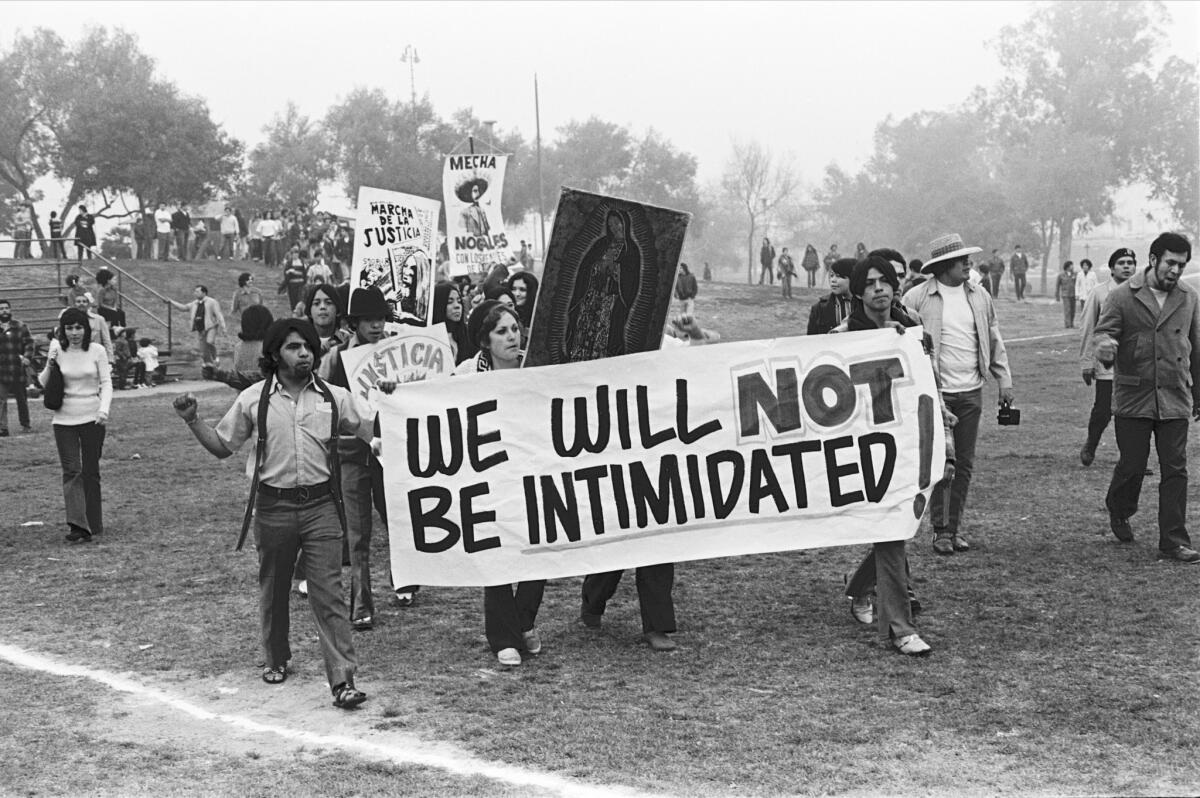
Standing Rock: Art and Solidarity, at the Autry. The Standing Rock protest in North Dakota attracted an unprecedented protest that brought together native and non-native cultures in a unified front against the proposed Dakota Access pipeline. This exhibition gathers ephemera from that action, including poster art, clothing and photographs. Through Feb. 18. 4700 Western Heritage Way, Griffith Park, Los Angeles, theautry.org.
Lezley Saar, “Salon des Refusés,” at California African American Museum. Painter Lezley Saar has long explored ideas of marginality and the cosmic in intimate paintings that feature figures both real and invented. Her new solo show at CAAM gathers works from various series exploring the in-between spaces of gender, race and the mind. Of particular note is a large painted textile, which hangs on the wall like a majestic Victorian tapestry, and depicts a woman with albinism — a striking stand-in for the artist, who is part black but looks white. Through Feb. 18. 600 State Drive, Exposition Park, Los Angeles, caamuseum.org.
“A Universal History of Infamy,” at the Los Angeles County Museum of Art. The latest in the PST: LA/LA series brings together the work of 16 Latin American and U.S. Latino artists that challenge notions of region. Many of the artists don’t inhabit a single country — often going back and forth between multiple locations, cultures and ideas. The show includes installation and performance by artists such as Brazilian Carla Zaccagnini, who is preoccupied with history; Stefan Benchoam and Jessica Kairé, who manage an egg-shaped mini-museum in Guatemala; and Colombian Angeleno artist Gala Porras-Kim, whose work often explores the ways in which culture is presented and interpreted. The show takes place across three venues, including the BCAM galleries at LACMA, the museum’s exhibition space at Charles White Elementary School near MacArthur Park (opening Dec. 9), and the 18th Street Arts Center in Santa Monica (through Dec. 15), where a number of the show’s artists had residencies. Through Feb. 19. 5905 Wilshire Blvd., Mid-Wilshire, Los Angeles, lacma.org.
“Día de los Muertos: A Cultural Legacy, Past, Present & Future,” at Self Help Graphics & Art. A historic exhibition looks back at the celebrations for Day of the Dead organized by the community arts nonprofit since 1972. This includes photography, historical prints and three specially commissioned altars from Ofelia Esparza, Marcus Kuiland-Nazario and Gerardo Yépiz (otherwise known as Acamonchi). Through Feb. 24. 1300 E. First St., Boyle Heights, Los Angeles, selfhelpgraphics.com.
Ken Gonzales-Day, “Surface Tension: Murals, Signs, and Mark-Making in L.A.,” at the Skirball Cultural Center. This is a new series from the artist known for conceptual photo projects that have chronicled old hanging trees and reimagined scenes of protest. For this PST: LA/LA exhibition he turns his attention to murals and the ways in which they inhabit L.A.’s urban landscape. Through Feb. 25. 2701 N. Sepulveda Blvd., Brentwood, skirball.org.
“Relational Undercurrents: Contemporary Art of the Caribbean Archipelago,” at the Museum of Latin American Art. Curated by Caribbean art scholar Tatiana Flores, this major survey of 21st century Caribbean art gathers a wide range of work — performance, photography, painting — by more than 80 artists with roots in the region. Organized by theme rather than region, the show looks at subjects common to the diverse populations of the Caribbean: colonialism, race and ethnicity, questions of history and identity, sovereignty, migration and sustainability. Through Feb. 25. 628 Alamitos Ave., Long Beach, molaa.org.
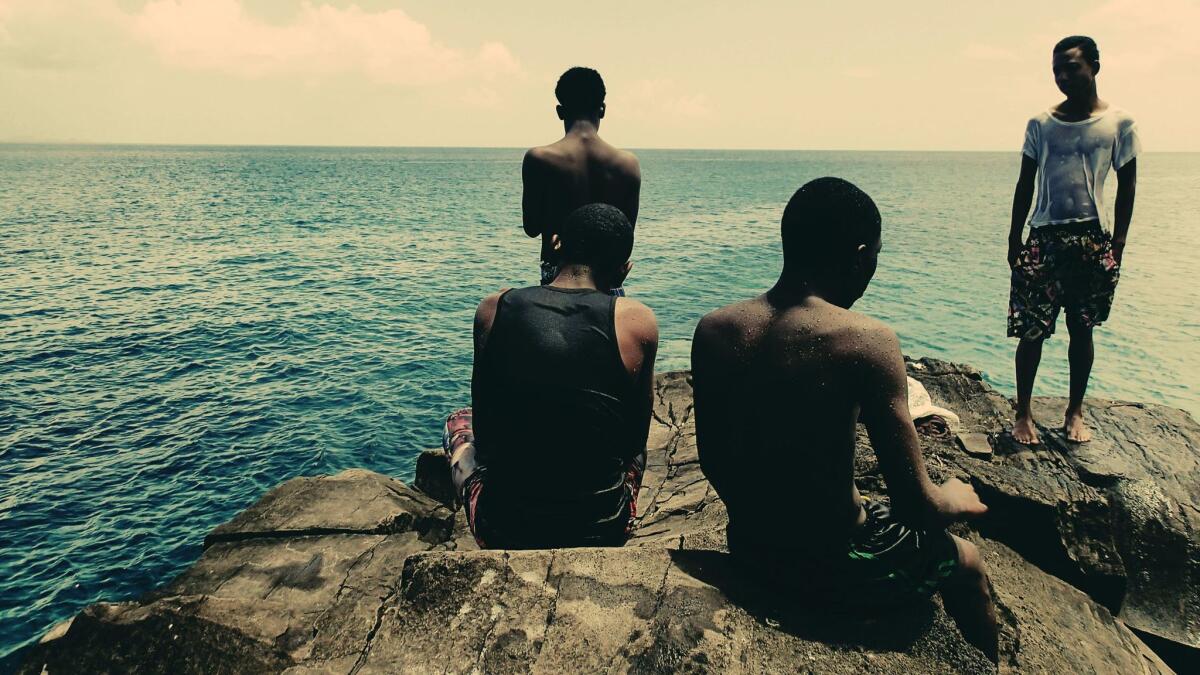
“Another Promised Land: Anita Brenner’s Mexico,” at the Skirball Cultural Center. Brenner was an American Jewish writer who was associated with an important cohort of 1920s Mexican modernists and was key to presenting Mexican art to audiences in the United States. The writer was close with figures such as José Clemente Orozco, Frida Kahlo, Diego Rivera and Tina Modotti — and some of their art is featured in the show, along with Brenner’s personal effects. Through Feb. 25. 2701 N. Sepulveda Blvd., Brentwood, Los Angeles, skirball.org.
Hugo Crosthwaite, “In Memoriam Los Angeles,” at the Los Angeles Methodist Museum of Social Justice. The noted Tijuana painter, known for phantasmagoric black and white murals that seamlessly fuse slices of urban life with the slightly deranged and fantastical, is creating an improvisational mural that is inspired by his observations of people in downtown Los Angeles. The mural will be painted only during the opening hours, during which time the public is invited to drop in and observe. After completing the work, Crosthwaite will then proceed to obliterate the piece by painting it out bit by bit. Through Feb. 25. La Plaza United Methodist Church, 115 Paseo de la Plaza, Los Angeles, museumofsocialjustice.org.
“Circles and Circuits: Chinese Caribbean Art,” at the Chinese American Museum and the California African American Museum. Latin American identity is often identified with the concept of the mestizo, the hybrid indigenous-Spanish culture that has predominated in large parts of Latin America. But the Asian contribution has been key to the development of culture, food and industry. This two-part exhibition looks at the Chinese presence in countries on the Caribbean Sea, including Jamaica, Cuba, Panama and Trinidad and Tobago. At the Chinese American Museum through March 11. 425 N. Los Angeles St., downtown Los Angeles, camla.org. At CAAM through Feb. 25. 600 State Dr., Exposition Park, Los Angeles, caamuseum.org.
“Transpacific Borderlands: The Art of Japanese Diaspora in Lima, Los Angeles, Mexico City and Sao Paulo,” at the Japanese American National Museum. This exhibition also examines the intricate nature of Latin American identity — which, in many nations, bears a distinctly Japanese stamp. Expect work by artists of Japanese heritage working throughout the continent, whose art explores issues of homeland, race and cosmopolitanism. Through Feb. 25. 100 N. Central Ave., Los Angeles, janm.org.
“The Reformation: From the Word to the World,” at the Huntington. It is the 500th anniversary of the Protestant Reformation and this is the second Los Angeles exhibition to explore the legacy of that momentous religious and social shift. (The first was at the Los Angeles County Museum of Art earlier this year.) Drawn primarily from the holdings of the Huntington’s collections, it features 50 rare books and manuscripts, as well as prints made between the 1400s and 1648 (the end of the Thirty Years War). Expect to see treasures by Albrecht Dürer as well as a real-deal papal indulgence signed by Pope Leo X in 1515 — a.k.a. the sorts of things you learned about in school. Through Feb. 26. 1151 Oxford Road, San Marino, huntington.org.
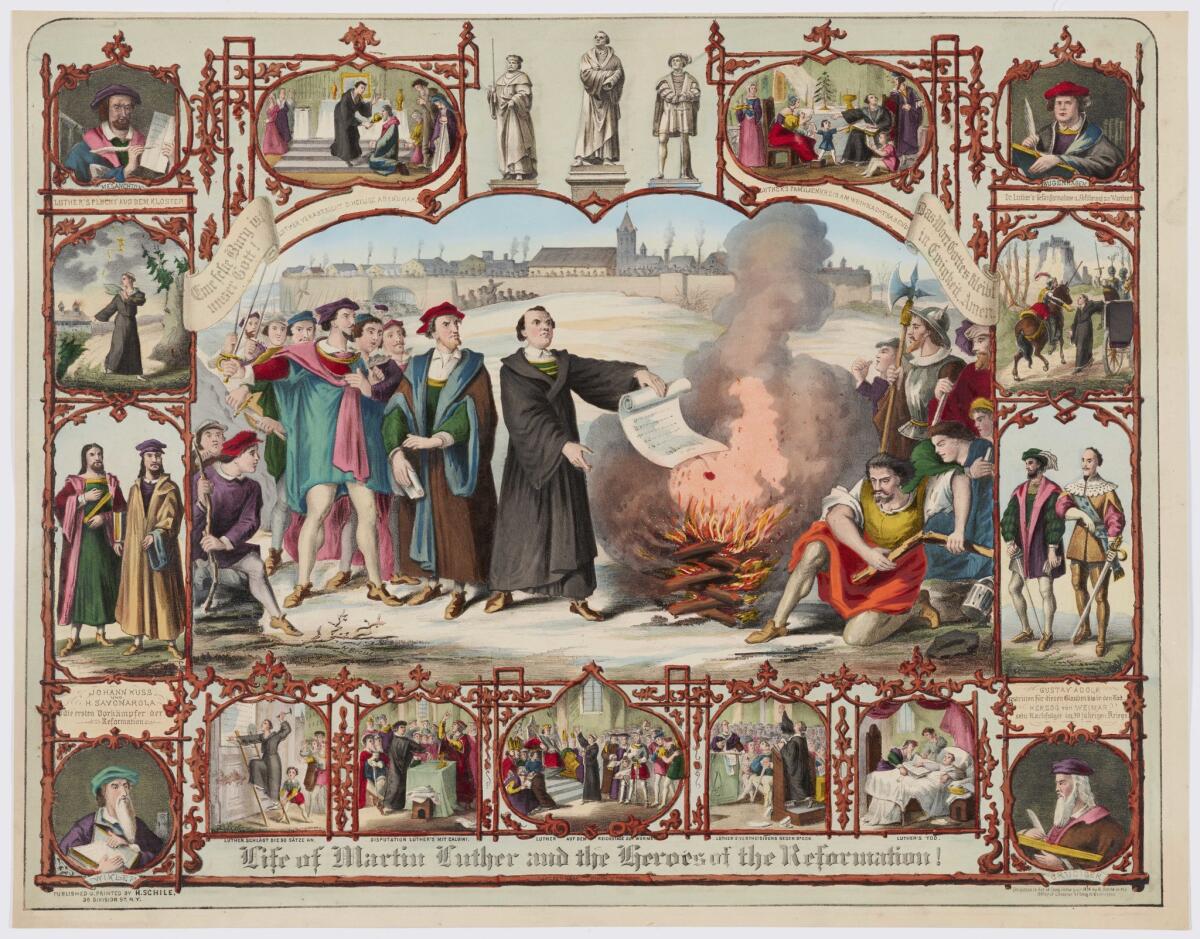
“¡Murales Rebeldes! L.A. Chicana/o Murals Under Siege,” at La Plaza. A historical exhibition looks at a history of Chicano muralism in Southern California through the works that have been censored and destroyed. This includes documentation of important works by iconic SoCal muralists such as Barbara Carrasco, Yreina D. Cervántez, Willie Herrón III (of Asco fame), Roberto Chavez and the collective known as the East Los Streetscapers (David Botello, Wayne Alaniz Healy and George Yepes). Through Feb. 27. 501 N. Main St., downtown Los Angeles, lapca.org.
“Found in Translation: Design in California and Mexico,” at the Los Angeles County Museum of Art. A groundbreaking design exhibition looks at the points of connection in design — architectural, fashion, graphic and other — between California and Mexico between 1915 and 1985. It’s a thorough examination of how designers in the two locales combined local materials with an interest in pre-Columbian and colonial design, as well as folk and craft traditions, to create singular approaches to Modernism that also overlapped in countless ways. The exhibition includes a diverse range of objects, including dresses, political posters, architectural drawings, furnishings and a show-stopping late 19th century piano carved in a pre-Columbian style. Wowza! Through April 1. 5905 Wilshire Blvd., Mid-Wilshire, Los Angeles, lacma.org.
“Axé Bahia: The Power of Art in an Afro-Brazilian Metropolis,” at the Fowler Museum. Brazilian art has been well-represented throughout the Pacific Standard Time exhibitions around the region. This show looks specifically at what has been happening artistically in Bahia since the 1940s, the city that represents the heart of Afro-Brazilian culture. This includes works by key Modernists, including Mário Cravo Neto and Rubem Valentim, as well as contemporary figures such as as Caetano Dias and Ayrson Heráclito — all represented in more than 100 works of sculpture, painting, photography, video and installation. Through April 15. UCLA, 308 Charles E. Young Drive North, Westwood, Los Angeles, fowler.ucla.edu.
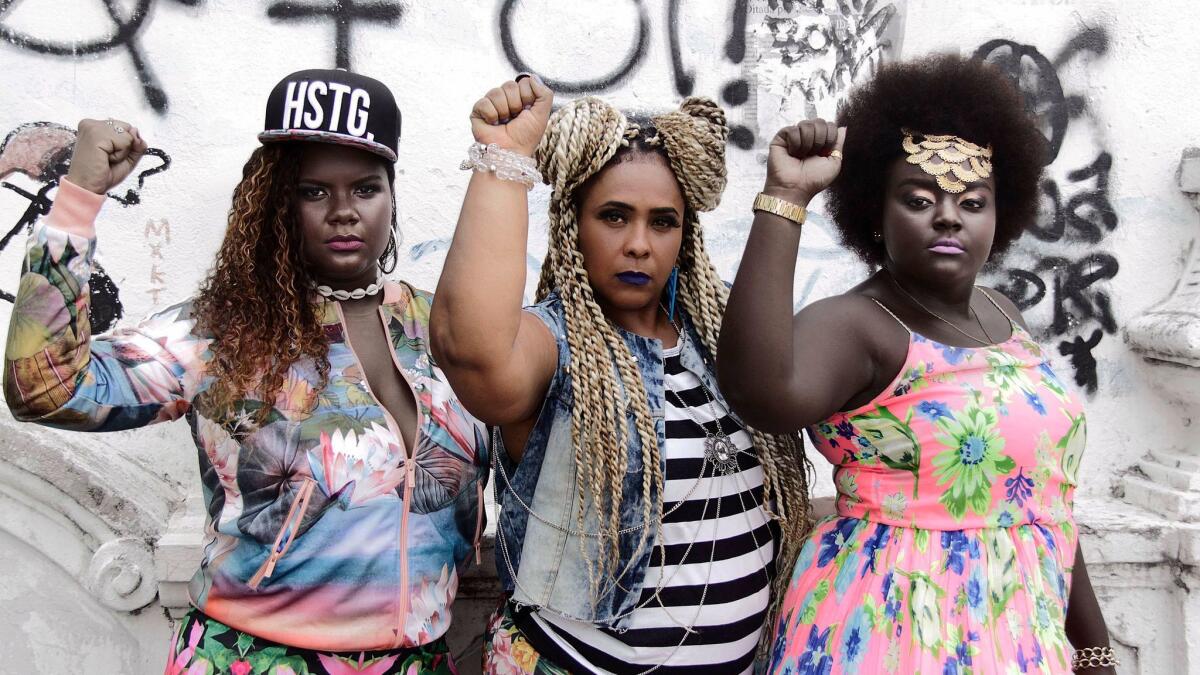
John Ford, Samuel Fuller, George Stevens, “Filming the Camps: From Hollywood to Nuremberg,” at the Los Angeles Museum of the Holocaust. Organized by the Mémorial de la Shoah in Paris, this exhibition looks at the vital work done by three key American filmmakers during World War II. Ford, Fuller and Stevens, in the employ of the U.S. Armed Forces and the Secret Services, filmed key aspects of the war — including the liberation of the Nazi concentration camps. The show includes film footage, personal letters, important ephemera and other rare objects and reflects on the way in which playing witness to Nazi atrocities shaped the worldview of these important directors. There could not be a more timely moment for this exhibition. Through April 30. 100 S. Grove Dr., Fairfax District, Los Angeles, lamoth.org.
Jose Dávila, “Sense of Place,” at West Hollywood Park. Visitors can expect to find a six-ton concrete sculpture by the Guadalajara-based artist, that will be dispersed in pieces to sites around Los Angeles, where the blocks will take on a life of their own. Next year, the pieces will be reunited back into their six-ton block, bearing traces of the neighborhoods they have occupied. Through May 2018. 647 N. San Vicente Blvd., Westwood, nomadicdivision.org.
Adrián Villar Rojas, “The Theater of Disappearance,” at the Museum of Contemporary Art. The Argentine-born artist, known for installations that transform spaces — and often play on themes of the apocalyptic — is taking over MOCA’s Little Tokyo space with an installation that employs the architecture and technologies of Hollywood special effects to create an environment that responds to a “post-human world dominated by technology.” Through May 13. Geffen Contemporary, 152 N. Central Ave., downtown Los Angeles, moca.org.
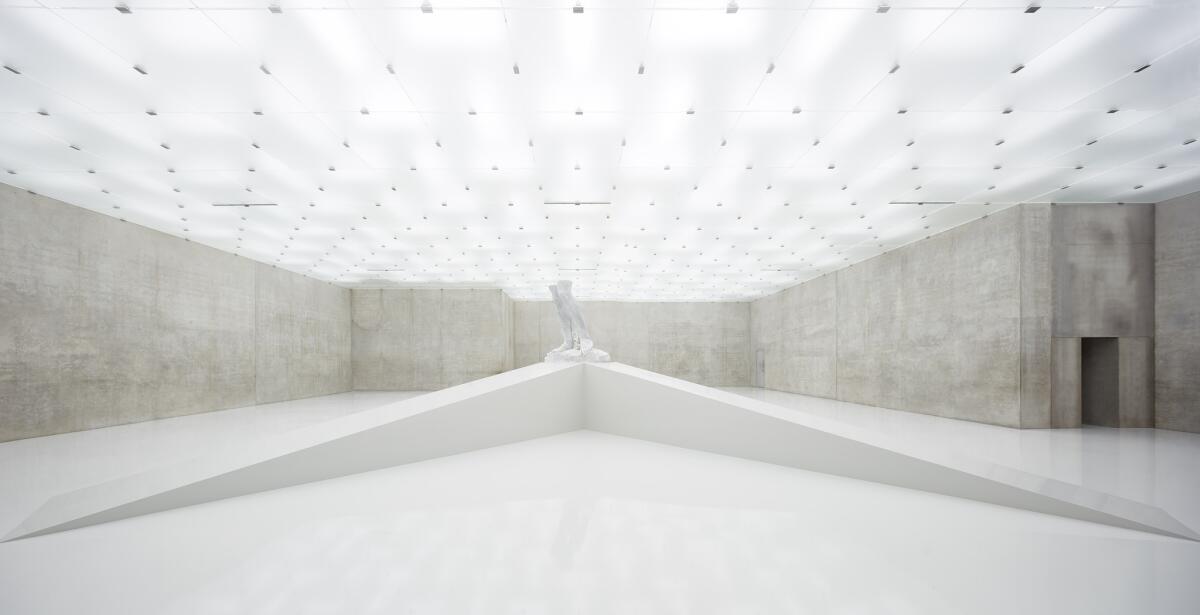
“Gary Simmons: Fade to Black,” at the California African American Museum. In a lobby installation — one that takes full advantage of its size and scale — Simmons pays tribute to forgotten African American actors and films. On a black background, the L.A. artist features the titles and names of films and individuals important to the early days of Hollywood history, but forgotten over time. Through July 2018. 600 State Drive, Exposition Park, Los Angeles, caamuseum.org.
“Artists of Color,” at the Underground Museum. As part of its ongoing partnership with the Museum of Contemporary Art, the Arlington Heights arts space has put together an exhibition that focuses on color — on its aesthetics, as well as the roles color can play as a symbol, affecting the way it’s perceived both socially and politically. The show includes works by an array of artists, including Ellsworth Kelly, Dan Flavin, Lita Albuquerque, EJ Hill, Felix Gonzalez-Torres, Josef Albers, Carmen Herrera and Noah Davis (the late founder of the Underground Museum). It’s a striking look at color seen anew. On long-term view; no closing date set. 3508 W. Washington Blvd., Arlington Heights, theunderground-museum.org.
“L.A. Communities Through the Eyes of Artists,” in the Passageway Gallery at Union Station. For 15 years, L.A.’s principal train station has been showcasing work that reveals the city through the eyes of its artists. This year, it is showing a series of newly commissioned pieces — including Shizu Saldamando’s depiction of Little Tokyo, Sam
Alejandro G. Iñárritu, “Carne y Arena,” at LACMA. The gripping new virtual reality experience by the Academy Award-winning director places the participant in the shoes of migrants making the arduous trek through the Sonoran desert to reach the United States. This may sound like the trivialization of what can be a fatal journey, but it is not. Iñárritu has considered all of the elements that surround his virtual reality video to humanize the story of immigration on the U.S.-Mexico border. I wrote about my experience of the piece in June. It’s not cheap (it’s a $30 special admission, in addition to regular museum fees) but it’s worth every penny. On long-term view; no closing date set. 5905 Wilshire Blvd., Mid-Wilshire, Los Angeles, lacma.org.
“Pow! Wow!” in Long Beach. The public mural series held in Long Beach every year is back with a series of nearly two dozen new murals in locations around the city, including parking garages and underpasses. Murals will be on long-term view in locations around Long Beach, powwowlongbeach.com.
Daniel Hawkins, “Desert Lighthouse.” The Los Angeles-based artist is obsessed with producing works that toy with ideas of grandiosity, failure and gestures that border on the Sisyphean. (One of his goals as an artist is to ultimately build a scale replica of Hoover Dam.) Now Hawkins has installed a 50-foot tall, fully functioning lighthouse in the Mojave Desert in the vicinity of Barstow. The piece even features a light to guide travelers through this rugged landscape. Directions and coordinates can be found on the website. On long-term view, Hinkley, Calif., desertlighthouse.org.
Sign up for our weekly Essential Arts & Culture newsletter »
Twitter: @cmonstah
The biggest entertainment stories
Get our big stories about Hollywood, film, television, music, arts, culture and more right in your inbox as soon as they publish.
You may occasionally receive promotional content from the Los Angeles Times.








